








Saturday, March 1, William and Mary men’s basketball (17-14, 11-7 CAA) wrapped up its regular season schedule with a 70-68 loss to Northeastern (17-14, 9-9 CAA) at Kaplan Arena in Williamsburg, Va.
Ahead of the 2:00 p.m. tipoff, the Tribe honored six graduating players as a part of its Senior Day celebration: graduate student forwards Malachi Ndur and Keller Boothby, senior guard Matteus Case, senior guard/forward Gabe Dorsey and senior forwards Caleb Dorsey and Noah Collier.
The game’s magnitude was apparent to all parties, as a coveted position within the top four of the Coastal Athletic Association standings was on the line for William and Mary. The last time the Tribe finished in the league’s top four was the 20192020 season.
With a lot to play for in front of a crowd of 4,355, Case, Gabe Dorsey, Boothby, Caleb Dorsey and Ndur started for the Tribe.
The Huskies won the tip but were unable to score on their first possession against the Tribe’s
Tuesday, Feb. 18, the WilliamsburgJames City County School Board convened to discuss a potential name change to James Blair Middle School. e three-hour meeting, which welcomed public comments from teachers, parents students and residents, resulted in the board voting 5-1 to establish an administrative name change committee.
Over the next three months, the committee will closely review historical information, survey to gauge community opinion and share their ndings with the board.
According to the WJCC school board’s website, the committee will compose 2-3 students, parents, and faculty from the middle school, as well as school board members, an administrator, residents and the assistant superintendent for school leadership.
If approved, the change would take e ect in August 2025.
James Blair co-founded the College of William and Mary in 1693, then served as its rst president for 50 years until
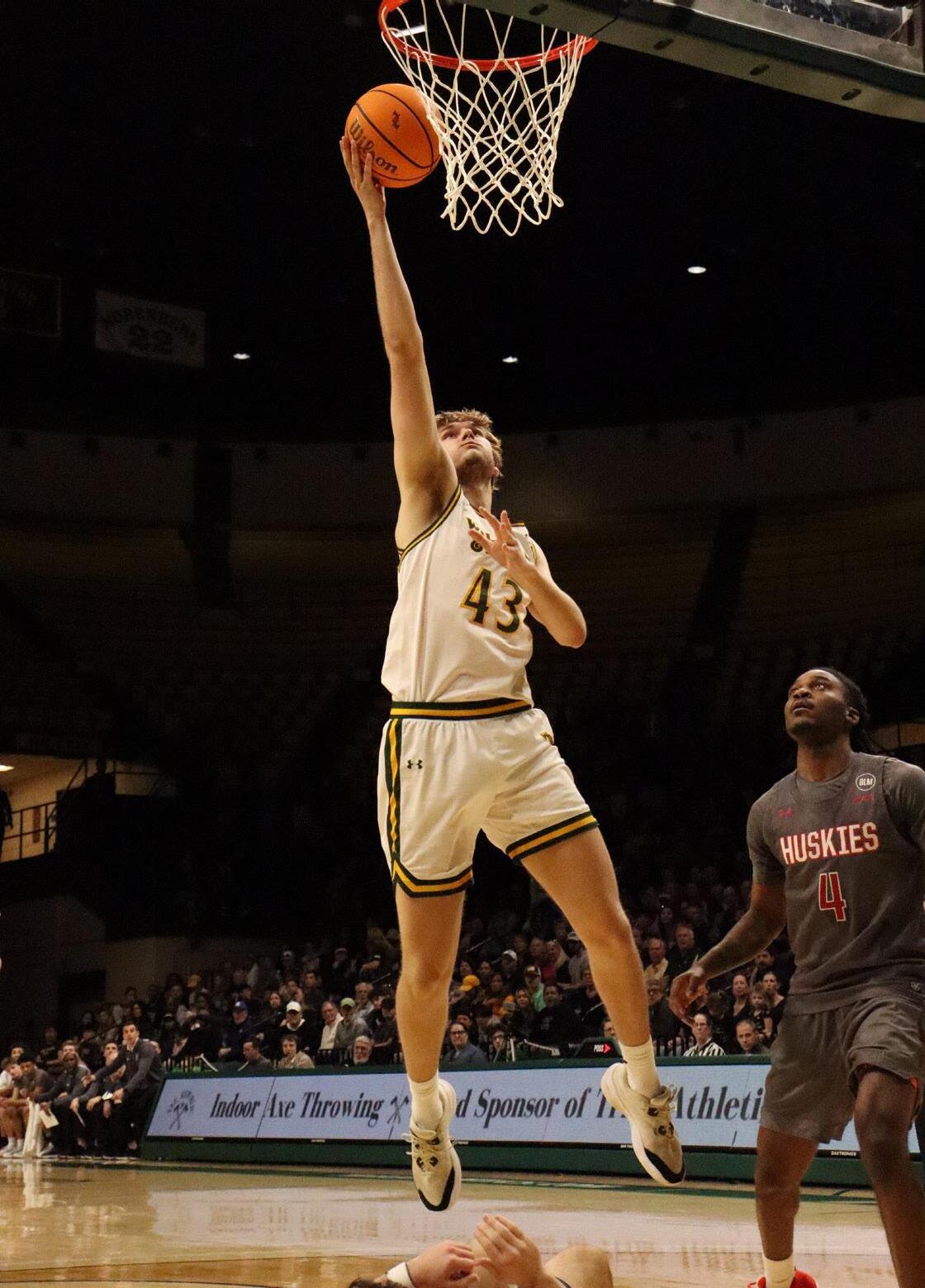
man-to-man defense. William and Mary got on the scoreboard after Gabe Dorsey found Boothby on the wing for a three-pointer. Caleb Dorsey doubled up with a wing three-pointer of his own, staking the Green and Gold to an early 6-0 lead.
Northeastern got its first bucket after breaking through the Tribe press and finding sophomore guard JB Frankel on the wing for an open triple, but William and Mary continued its hot start after inside shots by Caleb and Gabe Dorsey stretched its lead to eight.
Shortly after being substituted in, freshman guard Isaiah Mbeng drained a wing three-pointer of his own, marking the Tribe’s fifth made field goal in five tries. The Green and Gold’s first miss came on a Gabe Dorsey layup attempt. The score remained 13-5 for an extended period of time as both teams suffered through a stretch of sloppy play on both sides of the ball.
Northeastern junior forward Youri Fritz broke the scoring drought at the 13 minute, 47 second mark, converting a tip shot.
his death in 1743. During his tenure, Blair relied on slave labor from the region’s native inhabitants to build the College’s infrastructure.
e Committee for Contextualization of Campus Landmarks and Iconography outlined Blair’s role in exploiting slave labor for the College’s bene t on its website.
“He enslaved the natives of the land in order to provide students for the Indian School at the College, which in turn created more revenue for the College,” CCL&I’s website reads. “Blair often employed slavery when it would be of nancial bene t to the College and therefore himself. He was the rst to introduce enslaved people to the College, leasing his own personal enslaved people to the College to aid in its construction.”
e CCL&I’s 2023-24 Findings and Landscape Report, released last November, revealed that 25.75% of the College’s buildings are currently named after enslavers.
e College did not rename James Blair Hall, which houses the Lyon G. Gardiner history department, in 2021 following a months-long community
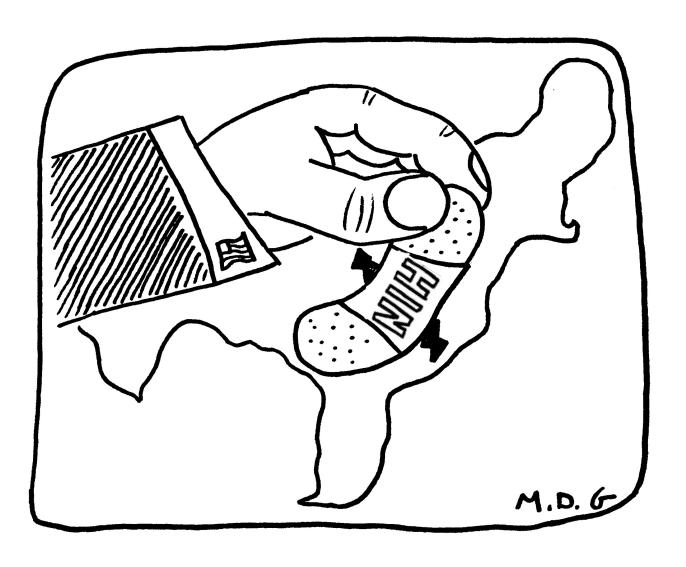
Mbeng immediately answered, coming off a Caleb Dorsey ball screen that freed the guard for a three-pointer.
Northeastern followed that with a three of its own from junior guard LA Pratt.
Boothby notched his second triple of the game after multiple swing passes found him open behind the arc, pushing the Tribe up 19-10.
At the 10:18 mark, Mbeng stripped the ball out of junior guard Harold Woods’ hands and fired a transition pass to Case, who rose for an electric righthanded dunk that lit up the Kaplan Arena crowd.
The Tribe offense then went stagnant for the next several minutes as the Huskies went on a scoring run to make the score 25-23 and come within one possession of the Tribe.
Both teams proceeded to trade trips to the charity stripe, with the next eight points coming from free throws.
Gabe Dorsey drained his first three-pointer of the matchup at the 2:04 mark of the first half, finding himself open after working the two-man game with his brother.
e ort to rename campus buildings named after racist gures. In April 2021, Morton, Taliaferro and Tyler Halls became Boswell, Willis and Chancellors Halls, respectively.
Associate Director of the Lemon Project Sarah E. omas explained that while the College decided not to rename Blair Hall, the Principles of Naming and Renaming Working Group recommended in their February 2021 report to College President Katherine Rowe that historical context be provided for the statue in Blair’s name.
“ ey did recommend speci c renamings and contextualized statues and portraits of Benjamin Ewell, John Tyler, as well as James Blair, omas Je erson and James Monroe,” omas said.
omas outlined the Lemon Project’s role in reviewing applications for name changes, including making recommendations to rename or contextualize campus landmarks.
“Anyone can submit an application,” omas said. “When an application is submitted, we’re a committee with the Lemon Project and Special Collections,

After Frankel responded with a three-pointer, Caleb Dorsey attacked the basket, converted a layup and drew a continuation foul, making it an andone play. Following the made free throw, the Tribe extended its lead to ten with 1:23 left in the period. At the 31 second mark, Mbeng found a cutting Case, who connected on a reverse layup. Mbeng then fouled Frankel, sending him to the line for two free throws. Frankel made both free throws, giving the Tribe the last possession of the half. With 20.9 seconds left on the clock, Mbeng held the ball and looked to run down the clock. Caleb Dorsey set a ball screen, rolled to the basket, received a pass from Mbeng and converted an open layup.
The Tribe entered the locker room up 41-31, bolstered by a 14-point half from Caleb Dorsey. “Caleb was great, he found his openings,” head coach Brian Earl said. “He did a great job lifting us up in that first half.”
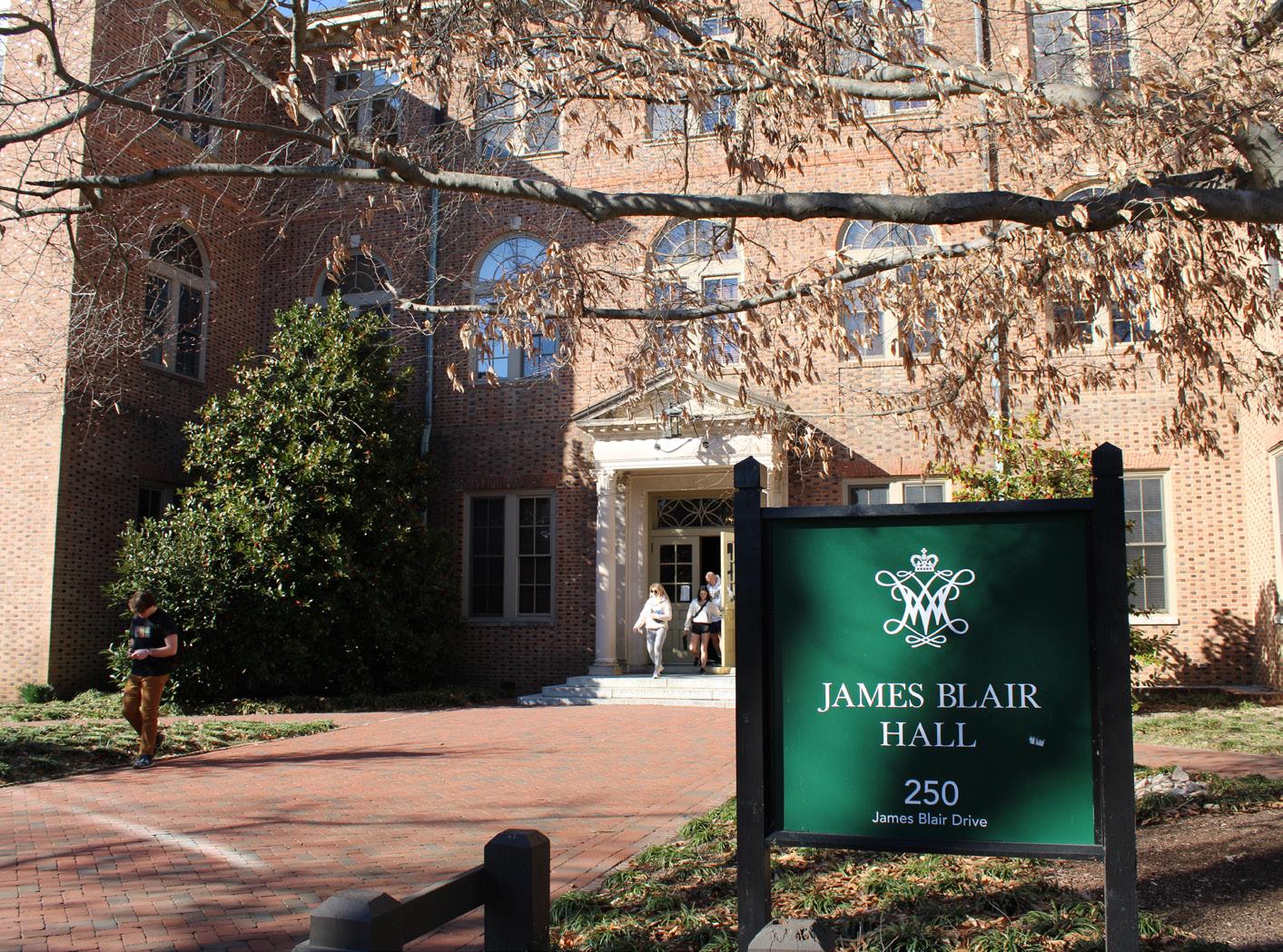
and we go through
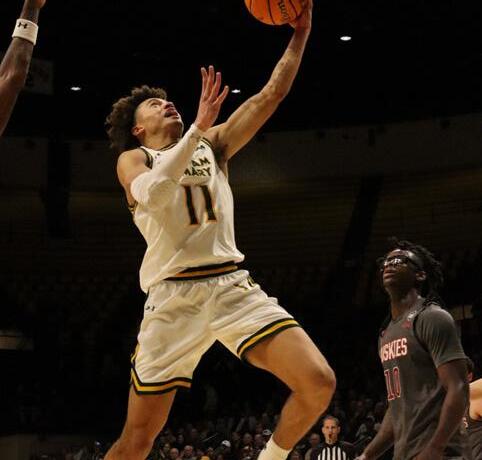
The best leaders are the ones who try to be a better leader tomorrow than they were yesterday. Theyʼre constant learners. They never feel like theyʼve mastered and figured it out. Theyʼre just on a long journey of trying to be an even better leader.
Mike Studeman
Wednesday, March 6, the Muscarelle Museum of Art at the Martha Wren Briggs Center for the Visual Arts will unveil its new exhibit “Michelangelo: The Genesis of the Sistine.”
Designed by curator Adriano Marinazzo, the exhibit displays Michelangeloʼs early sketches of the famous Sistine Chapel in Vatican City and will be available to visit through May 28.
The Muscarelle has just reopened in early February following an extensive $43 million renovation. It tripled the size of the museum and increased the number of galleries from 5 to 14.
In addition to the Michelangelo exhibit, the museum boasts a collection of original silkscreen prints by Jacob Lawrence and pieces on loan from alumni of the College.
The exhibit hopes to bring the unique experience of visiting the Sistine Chapel to Williamsburg. Alongside the drawings, the Muscarelle will feature life-size reproductions of the chapelʼs frescos and a portrait of Michelangelo by Italian artist Giuliano Bugiardini, which will be on display for the first time in the United States.
Marianazzo had to coordinate with the Italian government and multiple museums to gain permission to loan these sketches. Because the drawings are over 500 years old, the curators can only display the pieces for a few weeks every five years, highlighting the rare opportunity this exhibit presents. While Michelangelo destroyed most of his original drawings, 50 remain today ‒ 25 of which will be shown at the Muscarelle until this May.
A THOUSAND WORDS
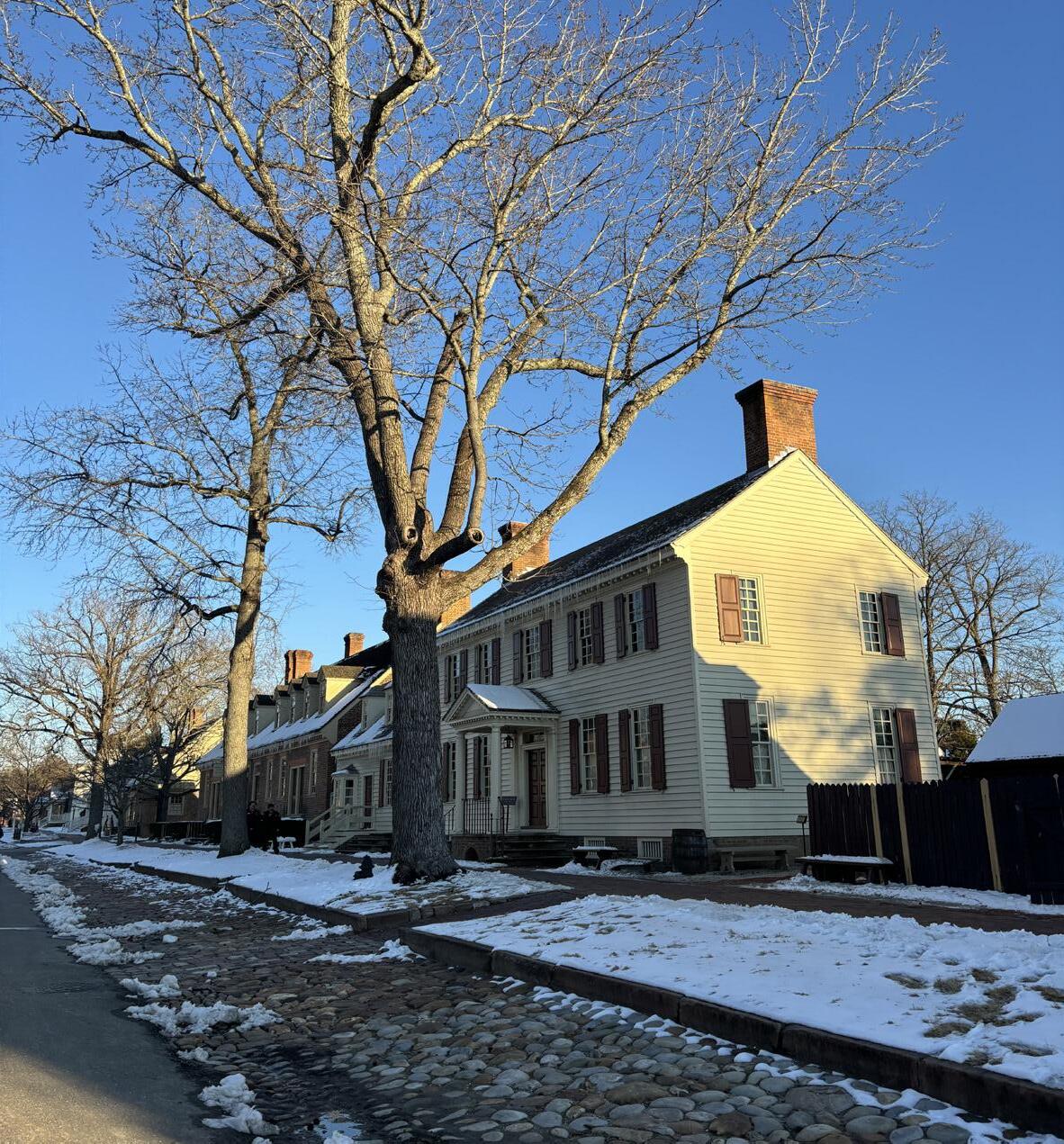

Talia Snyder Romero ’25 reflects on leadership as WMFIRE co-director, advocating for non-citizen
Talia Snyder Romero’s ’25 warm personality juxtaposes with her intense determination to bring change to the College of William and Mary’s campus and the greater Williamsburg community.
Snyder Romero is a member and co-director of the College’s Fighting for Immigrant Rights and Equity organization – WMFIRE – to which she helped breathe new life into during her freshman year following Joe Biden’s election, when it had fewer obstacles to focus on.
The club has grown from eight members to 20 this past year, and Snyder Romero suggested that the recent political pressure for immigration control contributed to the membership increase.
ʻSTABILITAS ET FIDESʼ | ESTABLISHED OCT. 3, 1911 Org #101 P.O. Box 8795, Williamsburg, VA 23187 Editor flathat.editor@gmail.com Managing flathat.managing@gmail.com Executive flathat.executive@gmail.com
“Immigration was a less hot button of a political topic, so it was interesting going into that space still caring a lot about immigration, and things like that,” Snyder Romero said. “From my freshman year to my junior year, I genuinely thought the club was going to have to dissolve because we had so little participation. But as Trump was campaigning again, and he got elected again, we’ve had a lot of people joining our organization, and membership has grown a lot.”
When reflecting on her work for WMFIRE, Snyder Romero noted that it’s one of her proudest achievements during her time at the College.
“Even though it’s for a kind of unfortunate reason, I am proud of the growth that WMFIRE has made and that we have been able to reach out to so many different kinds of organizations,” Snyder Romero said.
“Though we’ve been quiet over the past three years, we have been slowly working on little campaigns like letter writing campaigns to Congress and Initiatives like changing the William and Mary Admissions page in some of the vocabulary and just language and adding different resources for like a special status students who are applying to William and Mary and things like that.”
Snyder Romero is a psychology major with a minor in Hispanic studies, which aligns with her other involvements outside of classes. She is the tutor coordinator for Aprendiendo Juntos, which means “learning together” in Spanish, a community tutoring program that supports students learning English as a second language in elementary through high schools in the Williamsburg area.
Like WMFIRE, the tutoring program has also grown, with 116 student tutors volunteering in the past two years and over 70 just this past semester. Along with providing tutors in multiple subjects for the kids, the program also has family resource meetings and interviews with the mothers in these families, fueling research efforts by the College’s sociology and education departments about immigrant family dynamics.
Snyder Romero expressed gratitude for the tutors she works with, describing how meaningful it is to be involved in creating important changes.
“A lot of tutors return, which means that it was a positive experience for them,” Snyder Romero said. “So it just makes me feel very happy that people actually like doing it, not just care to do the work, but they come back because they like it for themselves and they also think it’s important, which means a lot because I like creating sustainability, longevity and things like that in the initiatives that I plan and do work for.”
Snyder Romero further hopes to inspire others to feel equally as passionate about these causes through her commitment and dedication to these organizations.
“I dream of more partnerships kind of between the high schoolers, middle schoolers, just overall like Williamsburg ESL students getting resources about how to apply to college or different career or post-high school pathways from WMFIRE,” Snyder Romero said. “Engaging in the community is something I hold so dear. I love getting off campus, and I love working with students on campus too, and I like working with SA and collaborating with other student groups. But, I think something I want to be remembered for is definitely how much I cared about families outside of Williamsburg and other community members, recognizing the intersections between tons of different community resources.”
Snyder Romero has found community in many different corners of the College’s campus and expressed how grateful she feels when they intersect.
“Finding kind of like your own niche and then finding a community that’s going to have your back and ultimately really care and show up for you is very nice to have, and I’m very lucky to have those friends from all throughout my past four years,” Snyder Romero said.
With her graduation approaching, Snyder Romero left some final advice for the College’s returning students, emphasizing the importance of finding one’s passion and prioritizing personal wellbeing, especially while balancing the transition into adulthood, building lifelong friendships and making a home.
“Don’t over involve yourself. There’s no shame in dropping commitments as long as you’re not on an exec board. Don’t apply for things that you don’t need to, and don’t add more to your plate than there’s space for. There’s no shame even in dropping a class. If you need to withdraw, take those 12 credits because that’s okay. I feel like as long as your mental well-being is cared for and you’re doing things you care about, that’s all that matters,” Snyder Romero said.
page 1
discussion with Admiral Mike Studeman ’88 Studemanʼs ʻMight of the Chainʼ emphasizes personal integrity, authentic leadership in workplace
Tuesday, Feb. 25, the Global Research Institute hosted a book launch for “Might of the Chain: Forging Leaders of Iron Integrity,” written by retired two-star Admiral Mike Studeman ’88. Held in Earl Gregg Swem Library’s Hive Event Space, the event featured a moderated discussion with Pamela Eddy, associate provost for faculty affairs and development, followed by an audience question and answer session and reception.
Studeman led thousands of intelligence professionals over his 35-year career in the Navy, culminating in his role as commander of the U.S. Office of Naval Intelligence. His book, which he described as an “Aesop’s fables of leadership,” shares lessons on leadership, integrity and resilience through stories from his national security and intelligence career.
During the discussion, Studeman reflected on the importance of ethical leadership, adaptability and decisionmaking in high-pressure environments. He emphasized that leadership is a lifelong learning process, shaped by the experiences and mentors individuals encounter. He described leadership as an ongoing journey, where the best leaders strive to improve daily.
“You are essentially a mash-up of all of the leaders you’ve ever experienced in life,” Studeman said. “The best leaders are the ones who try to be a better leader tomorrow than they were yesterday. They’re constant learners. They never feel like they’ve mastered and figured it out. They’re just on a long journey of trying to be an even better leader.”
Eddy, who moderated the discussion, noted that ‘Might of the Chain’ presents leadership in a relatable and accessible way for emerging leaders.
“What I really appreciated about the way the book was written was the accessibility of it,” Eddy said. “Especially for emerging leaders that are college students, it’s a first foray into how do I start thinking about leadership? It’s very relatable. So it’s a way for people to think, I, I could do that. That sounds like me.”
The event drew a mix of students, faculty and community
members. Among the audience was Margaret Xu ’25, a Navy veteran and kinesiology major, who engaged with Studeman during the question and answer session.
Xu reflected on her transition from military to civilian life, noting that while leadership in the military is structured and directive, civilian leadership allows for more individual choice. In both stages of her career, Xu has aimed to maintain personal integrity and moral leadership.
“Now that I am on the civilian side after separation, it is still a principle that I greatly want to live by,” Xu said.
She also discussed the differences in leadership styles between officers and enlisted personnel, explaining that enlisted ranks often have less autonomy in decision-making.
“The enlisted ranks do not always have the same freedoms that officers do, but integrity and moral leadership remain just as important,” Xu said.
Xu added that her military experience provided her with a strong understanding of both good and poor leadership, and that Studeman’s emphasis on ethical decision-making resonated with her.
The event was part of GRI’s ongoing book launch series, which began last year and has since grown in response to faculty interest. Ryan Musto, GRI’s director of forums and initiatives, explained that the series originally focused on faculty books but was expanded for this event to feature an alumnus.
“It started last year when we were going to host a book workshop for a faculty member here, Steve Hanson, and it was a great success,” Musto said. “It actually generated a lot of interest amongst some faculty members from across campus.”
Musto noted that Studeman’s event marked the first time GRI invited an alumnus as a featured author.
“With Admiral Studeman, it’s a bit different because he’s not on campus all the time,” Musto said. “We saw this programmatic offering as a way to bring in such a leader to campus, a very distinguished alum.”
Although the event was well-attended, GRI hopes to increase student participation in book launch events. Musto highlighted that while students were present, a significant
portion of the audience consisted of faculty and professionals.
“We saw great student turnout at smaller sessions with Admiral Studeman, like his lunchtime talk on naval intelligence and his meeting with our Global Scholars program,” Musto said. “We are always looking for ways to make these events more accessible to students across different disciplines.”
Beyond personal leadership, Studeman addressed broader challenges in politics, business and national security. He criticized the current political climate, arguing that poor leadership and division are eroding public trust.
“We have so many poor examples of leadership,” Studeman said. “Imagine kids growing up today, looking at powerful people, and saying, ‘I want to be like them.’ But if those leaders don’t operate from an ethical foundation, they will only divide and disappoint.”
See CAMPUS page 4
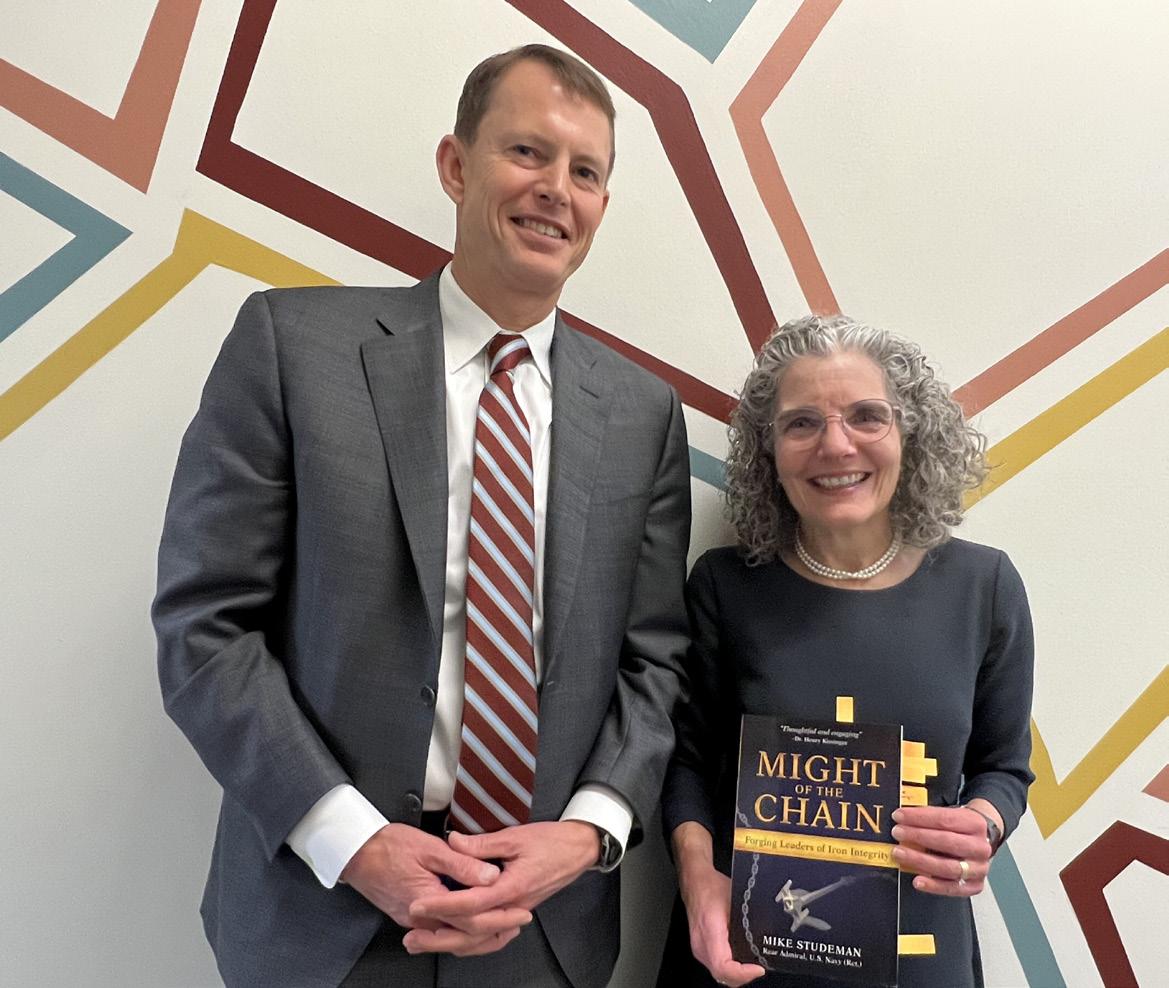
ROBIN PERDUE FLAT HAT NEWS ASSOC.
Thursday, Feb. 27, Dr. Dana R. Fisher delivered a talk titled “Saving Ourselves: From Climate Shocks to Climate Action” as the second lecture of the Environment and Sustainability Program’s “Envisioning Real Ecotopias” spring series. Fisher discussed the major themes and concerns she covered in her 2024 book, which bears the same title.
Fisher is the director of the Center for Environment, Community and Equity and is a professor of environment, development and health at American University’s School of International Service. PBS recently named her one of America’s most prescient thinkers on the changing politics of climate change.
This past January, the College of William and Mary announced its intention to celebrate 2025 as the Year of the Environment, promoting involvement in the Environment and Sustainability program and environmental action in the broader community. Fisher’s talk marks another step in the College’s effort to deepen its commitment to safeguarding the climate.
Fisher shared that she shifted her lecture’s key messages to parallel the changing status of the federal government. She placed stress on the importance of “saving ourselves” by remaining optimistic despite the current political situation and escalating effects of climate change.
“For now I’m here, and I’m going to continue talking about these things as long as I am allowed,” Fisher said.
She explained that substantial changes
AROUND THE ʼBURG
relating to countries’ perception of risk have altered the way humans operate and use resources daily. She concluded that building an understanding of how to properly respond to such risks will aid the global community in combating the climate crisis.
Fisher cited the global policy shift during the COVID-19 pandemic as an example of governments enacting dramatic change in response to high-risk threats to humanity.
“Society changed dramatically,” Fisher said. “The government stopped expecting things from certain people. We changed. Life changed substantially. It was the risk that changed our behaviors.”
However, Fisher emphasized the crucial role of civic engagement concerning climate activism.
“The state and the market won’t save us,” Fisher said. “Social change is most likely to come from civil society.”
She highlighted climate action events she attended with her research team, where they surveyed participants to better understand the growing public interest in climatefocused civic activism. These included the September 2019 Climate Strike, Earth Day 2023, the September 2023 March to End Fossil Fuels and the 2024 Summer of Heat.
“As I was writing the book I started out with interviews,” Fisher said. “It became really clear to me that there were people doing things on the outside.”
Fisher explained that she then focused her research on the “radical flanks” of grassroots climate movements, which help push the needle forward.
“As the movement wears on, some people
are frustrated with the movement and its progress and decide to act more radical,” Fisher said. “In the end what I speak about is how [radicalism] is helping to expand the movement.”
“If society doesn’t push back, what are we going to do?” Fisher posed.
She stressed the importance of three major elements in her book that political actors must consider when understanding how to “save ourselves” from the climate crisis. Fisher states that we must create a community based on real solidarity, capitalizing off moral shocks from climate change and cultivating resilient bonds to confront future crises.
Fisher segued into a more expansive look at public perception of protest movements. She aimed to determine general attitudes towards support of radical activism, highlighting her team’s experience at the 2025 People’s March.
Her findings revealed that 94% of attendees voted for Kamala Harris and that 84% supported organizations engaged in nonviolent civil disobedience to protest climate change. In general, supporters tended to be younger, less educated and further left-leaning than in past years.
“The resistance is not dead,” Fisher said. “The resistance is alive and well. The left is working together in collaboration against a common enemy. One thing we do know from history is that the state response when there is protest will be repressive.”
Ellie Long ’28 reflected on Fisher’s emphasis on protesting.
“I saw them as face-value and didn’t really
look into it,” Long said. “Now it makes sense why certain groups did [protest].”
Following her lecture, Fisher opened the floor for attendee questions.
In response to a question about how concerned we should be for the future of democracy, Fisher notably displayed her criticism for the current and future state of our nation, showcasing how the push for environmental activism goes beyond climate action alone.
“I can’t believe that I am here,” Fisher said. “At the moment I think we’re seeing so many norms shattering around what is America. What I think is the most important thing we all can do is figure out what avenues we have. Best case scenario, what we need to see is our elected leaders standing up. The best thing we can do is go to our elected officials and let them know what we think.”
Mary Veronica Kendall ’25 reflected on Fisher’s expansive view of political activism.
“Hearing her talk about very concrete ways to consolidate power as an opposition opens new avenues in my brain,” Kendall said. “If anyone from the university ever sees this, I would love for them to know that we would do a lot more to support student organizing, but also I acknowledge the institutional efforts made by hosting these kinds of events, and I think that in itself is wonderful.”
Fisher concluded on an optimistic note about the future of constituent-led climate advocacy and protection.
“What makes me optimistic is you guys,” Fisher said. What makes me hopeful is you guys. My job is to just help and support and encourage you. You have the power.”
College decided not to rename Blair Hall in 2021, called for co ntextualization of Blairʼs legacy
AROUND THE ʻBURG from page 1
Calls to rename James Blair Middle School intensified in recent weeks, citing Blair’s legacy as a slaveholder. At the WJCC school board meeting, community members expressed mixed views over forming a name change committee.
Williamsburg resident Susan Franz argued that institutional culture affects students’ experience and sense of acceptance more than a school’s name.
“A name does not cause an environment to be equal or unequal, oppressive or non-oppressive,” Franz said. “A name is just a name. On the other hand, school culture can cause feelings of inequality or oppression.”
Franz shared her belief that raising student performance should be a more urgent priority for the WJCC school
board than changing the middle school’s name.
“Board and staff time is better spent determining how to improve the abysmal math and English scores of our students,” Franz said. “No matter what race they are, that is what would benefit them more than planting an idea that the name of a school or any building has some power over who they are or what they can achieve.”
Camille Batts ’26 spoke at the Feb. 18 school board meeting on behalf of CCL&I. She endorsed the middle school’s name change, connecting it to CCL&I’s core mission.
“Much of our work aligns with this campaign to rename James Blair Middle School, and we are here tonight to show that we as students and community members support our local community,” Batts said. “To consider renaming James Blair is to pave the
way for James Blair Middle School students, present, past and future, to feel welcome.”
Batts emphasized that keeping the school’s name would further isolate Black students, encouraging the board to consider another figure that would bring positive change.
“For Black students to attend a school named after a man who perpetuated and institutionalized enslavement, whose ideals were then utilized to resist integration, is completely unacceptable,” she said. “Names hold immense power, and there are ways to use this power to memorialize figures who represent the values and morals we hope to instill in the community.”
Alynn Parham
M.A.Ed. ’18 is a social studies teacher at Jamestown High School who spearheaded the addition of African-American history
courses to the curriculum. Parham advocated for the name change at the school board meeting.
“I would encourage the board to support the renaming of James Blair Middle School,” Parham said.
See AROUND THE ʻBURG page 4
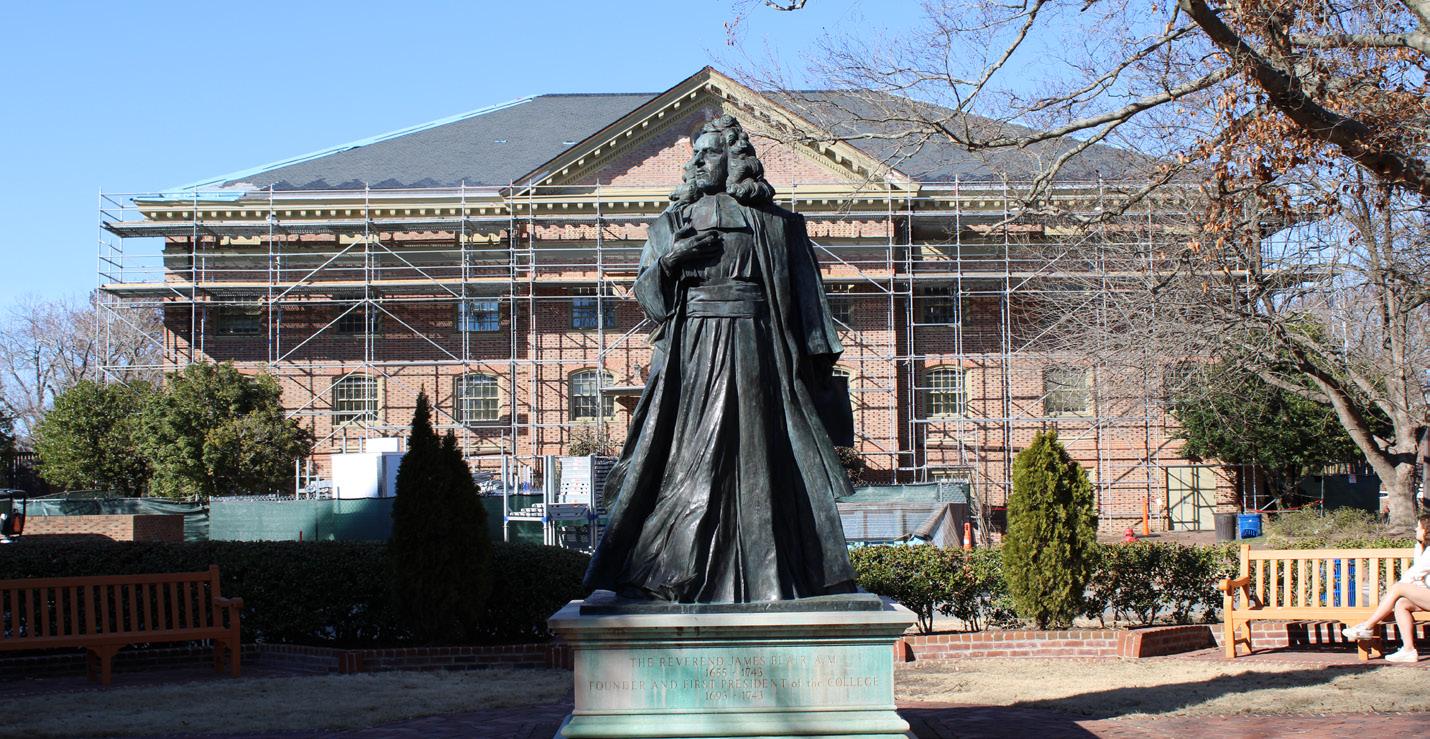
“By now, you’re well aware that James Blair founded the College of William and Mary by enslaving people,” Robinson said. “But Blair was also an ordained Anglican minister and used perversions of the Bible to justify slavery and to turn a profit in the Virginia colony. For Blair, Christianity was a vehicle for economic conquest.”
Robinson mentioned the segregationist principles that inspired the then-high school to be named after James Blair in 1955, calling for a name change that promotes inclusivity.
“James Blair laid the foundation for segregationist ideology that took hold in the last century, when this school was named for him,” Robinson said. “For us, the path forward is simple. We must change the name of James Blair Middle School.”
Sen. Mayer Tawfik ’27 served as lead sponsor of a November 2024 Student Assembly resolution entitled “Naming Architecture with Meaningful Epigraphs.”
Tawfik shared the resolution’s goal of boosting student involvement in renaming campus landmarks. Concerns over a lack of community input surfaced after the College renamed Brown Hall to Gates Hall in March 2024.
“The bill was sort of in response to what we felt was a lack
ALEXANDRA NAKAMITSU
Tuesday, Feb. 25, the Student Assembly Senate of the College of William and Mary met in the James room of The Sadler Center. The chamber introduced two new bills, passed one and debated two.
Chair of the Senate Sen. Hazel Vineet ’25, Sen. Ryan Silien ’28, Class President Matthew Hwang ’25 and Sen. Peerawut Ruangsawasdi ’26 introduced the Earth Yay Act Pt. 3 that was launched at Charter Day on Friday, Feb. 7 in response to the Year of the Environment. The bill would allocate $1410 for an event held in April, emphasizing sustainability and celebrating Earth Day. The event will be organized and planned in partnership with the Veggie Society and the Office of Sustainability.
“It’s not a ton of money, and it’s a really fun way to get the campus community involved in Earth Day celebrations,” Silien said about the event.
Class President Zoe Wang ’26 and Sen. Matt Swenson ’26 introduced the Colonial Relays Carnival Act. William and Mary Track and Field hosts their annual Colonial Relays event through April 2-5. This bill would allocate $680 to host a carnival on April 4 to draw more engagement and participation in the Colonial Relays. The carnival would include a dunk tank, mini golf and athletic booths like tennis and basketball.
“Because student athletes have different schedules and responsibilities from other students, it can be difficult for student athletes to feel integrated within the broader school community. Holding events that bring together is a strong way to help bridge divides and inspire collaboration,” the bill states.
The chamber continued debate over The Strategy Process for Reserves Act, sponsored
He emphasized the need for collaborative problem-solving and compromise in leadership.
“You have to be willing to listen to others and you have to be willing to compromise,” he said. “If leaders refuse to do so, they are setting themselves up for failure.”
Studeman also re ected on the role of AI in leadership and communication, sharing his experience using ChatGPT while writing his book.
“I actually submitted my content to a ChatGPT program to try to condense the key things as I worked,” Studeman said. “And what I got back was less than what I had expected. The emphasis wasn’t in the right place, and it just looked too hard to bring up to standards.”
While AI can be useful, Studeman emphasized that strong leadership and storytelling require human depth and creativity.
“These machines don’t provide the air, style, and vibrancy that authors can,” he said.
Xu, drawing from her background as both a veteran and a student, echoed these concerns.
“When people are in uenced uniformly, it impacts their ability to make decisions,”
of student involvement in the naming process,” Tawfik said. “Hopefully, we’re aiming to have students be active participants in the process and active agents for change. But baseline, if that doesn’t happen, at least it would be a way for administration to gauge what reactions would be from students.”
Tawfik reflected on both sides of the middle school’s name change debate.
“There is an argument to be made that this is history and you can’t erase history and you have to learn from it,” Tawfik said. “But at the same time, you could learn history without making an icon out of people who have oppressed other people, who have done horrible things and who have pushed this image of dominance throughout the years.”
Tawfik addressed the effect of a building’s name on students’ sense of belonging at the College, which he feels should be universal.
“Regardless of whether there are valid reasons to keep the name, you can’t deny that some students will feel alienated and that students will look at that and sort of question the motives of the university,” Tawfik said. “And that’s not really what we want. We want students to feel welcome. We always say, ‘who comes here belongs here,’ and we kind of have to prove it. We kind of have to demonstrate it.”
by Swenson. The bill aims to add several amendments regarding finances and SA spending to both the Constitution of the Student Assembly and the Code of the Student Assembly.
Currently, all Senate initiatives are funded by the Reserves fund, which comes from the Student Activities Fee, which is charged to every full-time student at the College. The Reserves fund is subject to the discretion of Senators on how it is used.
The allocated amount in the Reserves fund is highly variable year to year, depending on Recognized Student Organization funding and spending disparities. In fiscal year 2024, the fund has $945,311.58, while the fiscal year 2025 allocation was $749,096.62. This bill aims to create stricter guidelines and voting thresholds for bills that request a certain amount of money.
“The status of Reserves is often at risk of becoming a nebulous concept, and thus Senate debate over spending bills can sometimes lack prudence and clarity,” the bill states.
Changes to the Code will include a mandatory Annual Reserves Resolution. Within three weeks of the new academic year, senators will be required to agree – on a two-thirds majority – to a threshold on spending for each bill, based on the allocated reserves funding for that fiscal year. Any bill that exceeds that threshold can only pass with a two-thirds majority. If the Senate fails to uphold this system, they are subject to adjudication by the Review Board.
Changes to the Constitution include a clause that would allow the Senators to self-impose this two-thirds majority on any piece of legislation. All bills that exceed the spending threshold must also state in the bill an estimate of how many people will benefit from the bill.
Xu said. “AI is just one more in uence, so we need to be mindful of the in uences we allow near us.” The book launch and discussion reinforced GRI’s role in fostering interdisciplinary conversations at the College. Studeman, re ecting on his return to campus, emphasized the importance of integrity and staying true to one’s values as a leader.
“If you start to become inauthentic, people can’t trust you because they’re not sure that’s you,” Studeman said. “There is a price for inauthenticity, and it may be something that’s silent and nobody ever tells you, but it’s there.”
GRI plans to continue its book launch series with upcoming events featuring faculty authors and guest speakers. For students interested in leadership, policy or intelligence careers, Musto encouraged engagement with GRI’s research initiatives, forums and mentorship opportunities.
“When students get to meet with practitioners who have impressive real-world experience, it enriches their understanding of applied research and real-world challenges,” Musto said. “We’re excited to continue hosting these events and hope to see even more student participation in the future.”
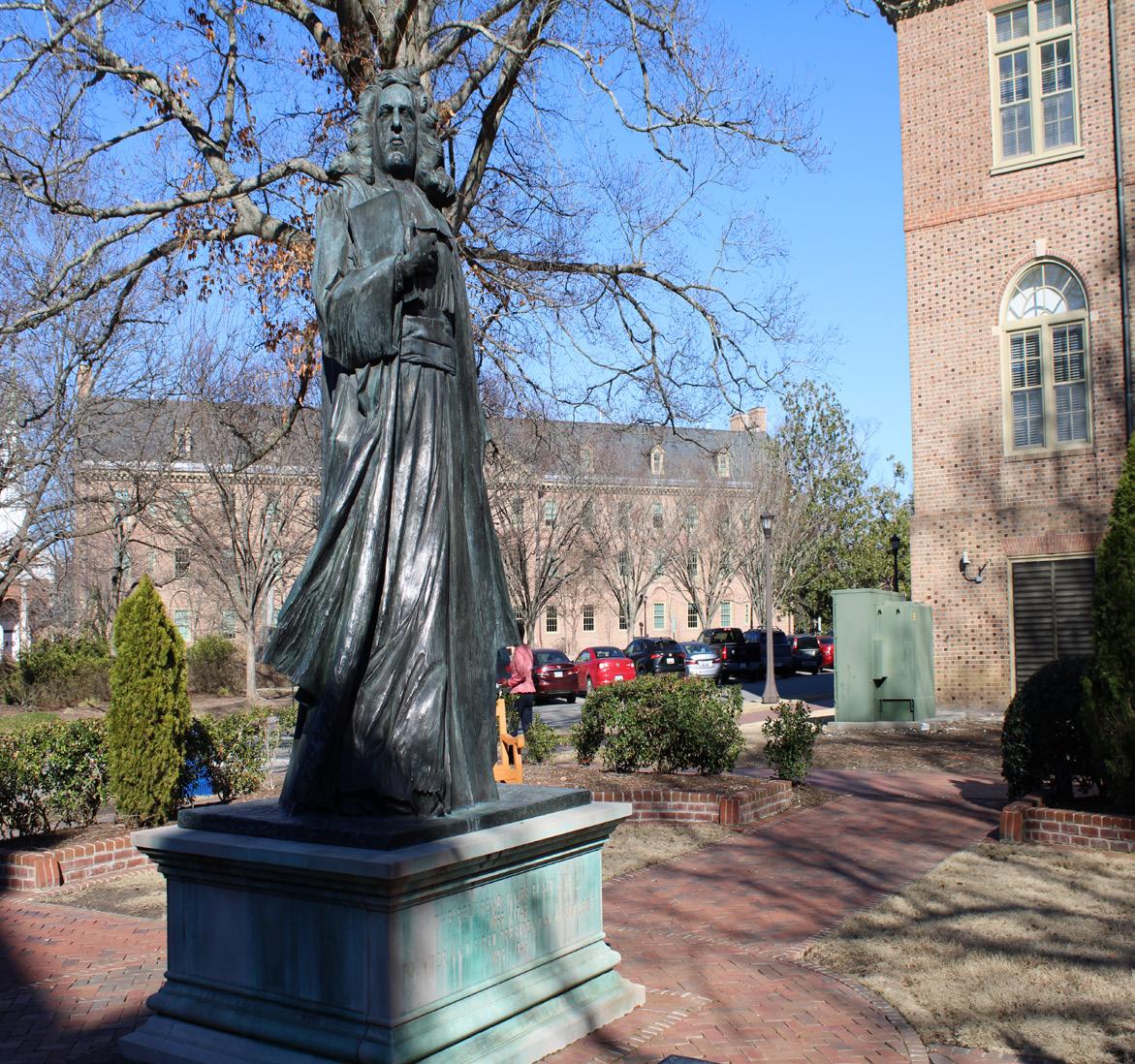
This bill has been highly contentious within the Senate and has been under review for the past two weeks. During this time, Swenson has made multiple amendments to the bill.
Skeptical senators are mainly concerned with the Annual Reserves Resolution. Some are concerned about what would happen if a resolution is unable to pass, while others are concerned about the clause that allows for the Review Board to adjudicate on the Senate.
The bill is yet to be voted on, and has entered another week of review by committees, as it continues to be amended.
The Act, introduced during the meeting of Tuesday, Feb. 11 by Class President Zoe Wang ’26, Sen. Yasmin Kudrati-Plummer ’28, Sen. Sophie Kennedy ’27 and Sen. Cheryl Dao ’27, was amended and brought to the chamber for another week of debate. The bill now states that 500 tampons and 500 sanitary napkins will be distributed across various locations on campus. The bill would also allocate funds to distribute reusable menstrual cups and reusable pads to students.
The amendment of the bill lowered the cost from $6000 to $2500. The bill does, however, leave some funds to allow for additional products to be ordered. When asked about distributing to locations outside of the main campus, Wang said, “That’s why it’s a little higher at $2,500 so that if you know, if law school wants more, you can also help place that order too.”
The chamber passed the Pride Month Act, sponsored by Wang, Swenson, Dao, Class President Nico Giro-Martin ’27 and Sen. Nina Argel ’28. The bill will allocate $4945 for various Pride Month activities and events. The events will take place in April, as the official Pride Month in June takes place over summer break. Events will include Queer Prom, Pride Fest and an LGBTQIA+ Research Symposium. The bill also requires a planning committee
composed of executive members from various LGBTQIA+ clubs on campus.
There was pushback on this bill that stemmed from belief that Recognized Student Organizations focused on LGBTQIA+ advocacy and visibility should be the ones organizing this event instead of Student Assembly. The RSOs should also be the ones receiving funding from the Organization Budget Allocation Committee process. Students from Drag and Drop — an RSO promoting and educating on the art form of drag — came to the meeting to express support for the bill.
Sebastian Cannito ’25 was among the students who attended to speak on behalf of the bill. He said that the planning of Pride Month activities was typically the responsibility of the William and Mary Lambda Alliance, but that the organization has dwindled in membership in recent years, and support from SA was necessary.
“We’re doing this because we’re filling a hole that Lambda left for the queer community audience that makes sense and shed some light on who’s involved,” Cannito said.
The bill passed with a majority vote, with VIMS Sen. Mara Walters abstaining.
The executive followed up on an Open Question posed by Silien during the meeting held Tuesday, Feb. 11, regarding the Committee for the Contextualization of Campus Landmarks & Iconography. Silien asked about fliers that had been posted across campus by CCL&I without approval from the College criticizing and mocking the names of the College’s landmarks and academic buildings. Sloane clarified that if CCL&I were to be considered a part of the Student Assembly, they would be under the purview of the Executive branch. She stated that further discussions will continue before Spring Break as to what the relationship between SA and CCL&I will be.
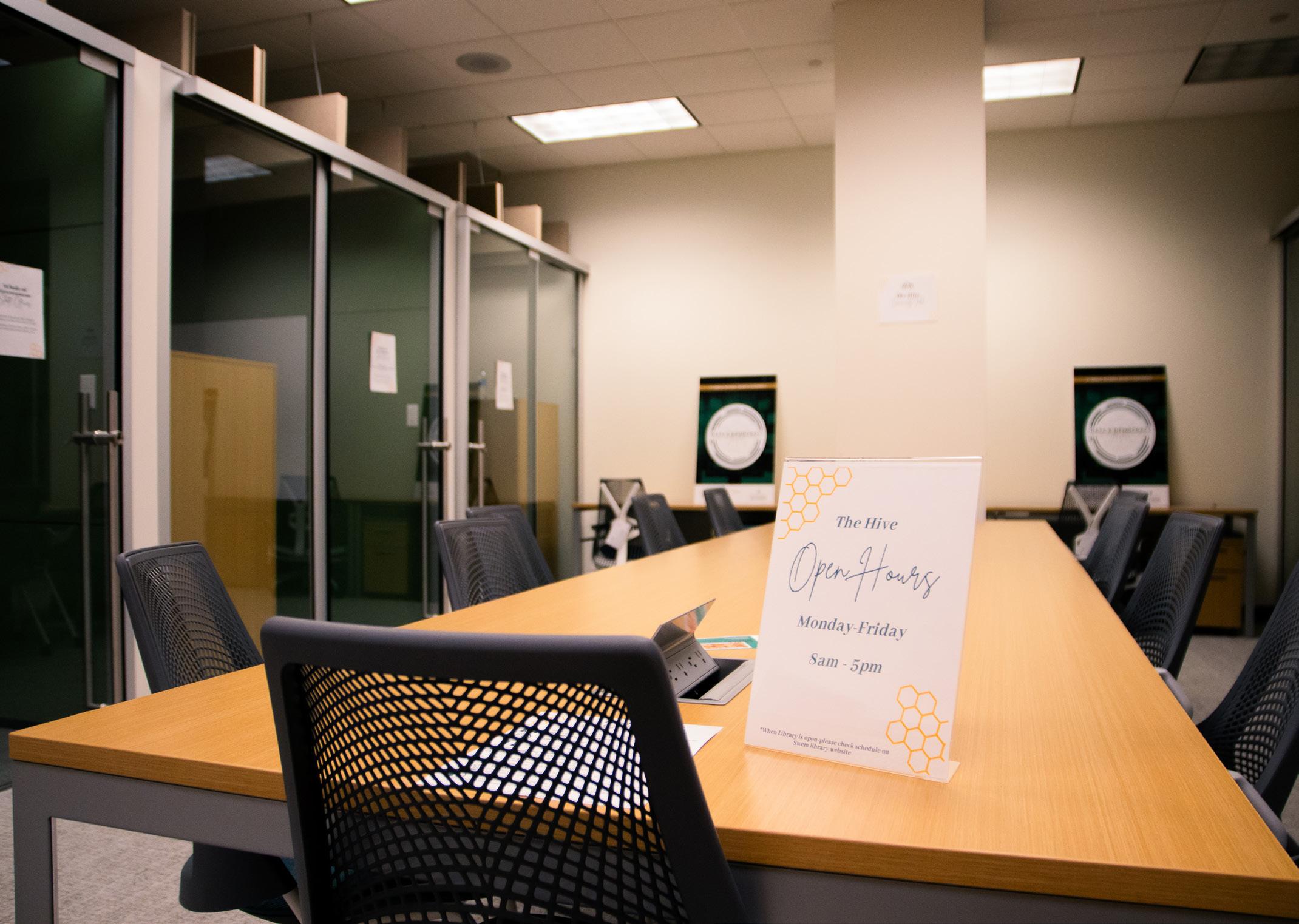
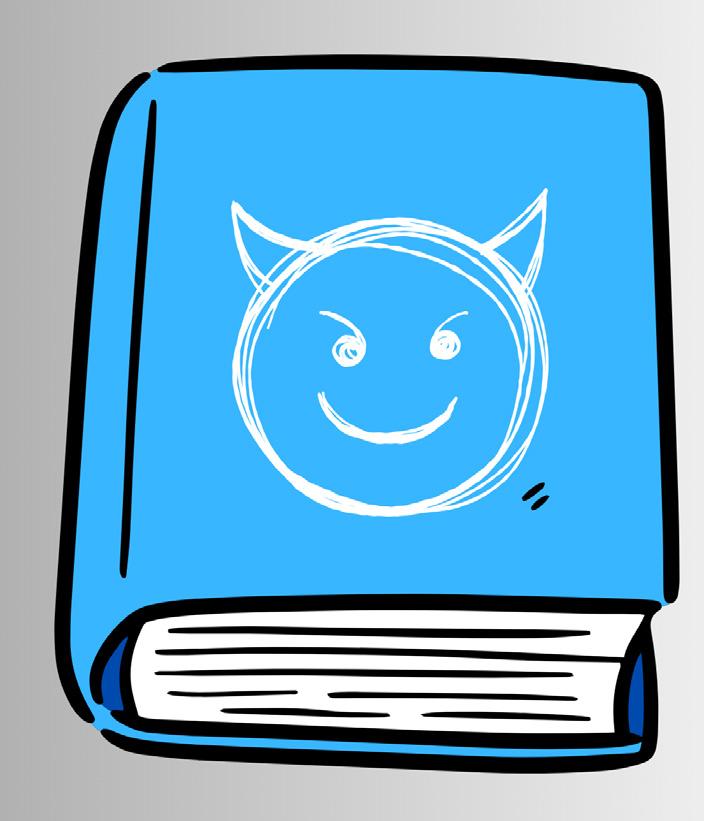
Cue the ominous shot of Earl Gregg Swem Library, and an impassive student walking in and ascending the stairs to the second floor. There, light-green signs and fluorescent lights dominate the rows of computers and condensed bookshelves. Not a word is said from the moment this student enters to the moment they sit down at the double-monitors, signing in to their wm login with a woeful sigh. Such is the scene in my head as I prepare myself for a long night of watching YouTube videos to recover from deficits in my professor’s teaching ability (or my attention span — who’s to say?). All that really matters at this moment is that my first exam for biochemistry is tomorrow. The outside world, the joy of seeing my family, watching the warm spring sunlight enrich the vibrant colors of campus — all these things tug at my heartstrings, deep, deep below the harsh necessity of memorizing the amino acids and knowing what a pKa is.
The soundless air absorbs my misery as I whimper, drawing arginine incorrectly for the third time. Is it nonpolar? I don’t think so. So it’s polar, but acidic, basic, neutral? With a timorous heart, I swallow my despair and look it up: basic.
I gaze outside the window with a feeling of pure futility. A wide river of grief flows through me as time passes in the beautiful, shining world, eternally separated from me by a pane of glass. Surely there must be a better way, an escape from this torturous fate. Why have I not studied before now? I have so many critical things in my life that I must do before I can study: books to read in order to avoid doing work, friends to talk with in order to avoid doing work and TV shows to watch in order to avoid doing work — in particular, the ongoing second season of “Severance.”
Hopefully you are at least familiar with the premise of “Severance.” In the show, people can separate their memories and sense of self from when they are at work versus in their personal lives, essentially becoming two distinct people: their innie, with the responsibility of work, and their outie, free to enjoy that work’s benefits. Okay, that sounds pretty cool: half of me gets to do mysterious work in a completely focused environment, while the rest gets to enjoy my passions without the weight of assignments looming over me.
WRONG! In the first episode, Helly R., maybe the most likable and interesting televi-
sion character of all time, asks her boss on the severed floor if they’re in hell after she repeatedly attempts (and fails) to leave. Though he assures her that they’re not, there is a depressing eeriness to their nonsensical work: sorting numbers based on what emotions they evoke, all for rewards such as stickers, finger traps or, once a financial quarter, a pancake party. To sever the part of yourself that does work from the part of you that supposedly enjoys your life would fail to actually increase the quality of your life; as Shakespeare wrote in “Henry IV Part I,” “If all the year were playing holidays, / To sport would be as tedious as to work.”
And none of the severed employees are actually particularly happy in their outside life. One is a grieving alcoholic. Another is chronically aimless, haphazardly trying to find his passion in life, and another is obsessed with the company that he works for. Though the severed workers enjoy high pay for their (or rather, their innie’s) work, this huge gap in the total experience of their life only leads them into greater pits of unhappiness. Though we don’t always see the logic of why we have to study for this test, write this paper, etc., at the end of the day, we can choose to select certain responsibilities and oblige ourselves to work toward them. The outies of severed workers experience no professional productivity at all, creating an imbalance that leads their lives to be largely unrewarding and purposeless. The innies of severed workers experience total productivity, but the end product of their work is totally unknown and potentially murderous. Furthermore, no aspect of their work is in their control, since their outies condemned them to eternally work for the whims of an insidious corporation.
Though most of the innies eventually accept their fate in the liminal white hallways and corporate colors of the severed work floor, Helly R. unfailingly refuses to accept the conditions of her existence. When her outie declines her resignation attempt and derides her for wanting to leave (going as far as to say “I am a person. You are not,”), Helly works through the rest of the day with a smile, and then, at the end of the day, she promptly attempts to hang herself in the elevator, leaving her outie to wake up choking on an extension cord.
Using your energy for the work that you deem meaningful is tantamount to living a life that you actually want to live.
While this responsibility can feel overwhelming to certain obsessive neurotics (definitely not me), it really is a gift to have agency in life, and a little silly to realize the lengths we go to in order to avoid confronting that responsibility. “Severance” is just an extreme example of a pretty common phenomenon.
We are not two people living in one body: a worker and an enjoyer, an innie and outie.
The person who does work should do it as conscientiously and freely as the person who does more leisurely activities for enjoyment. Rest, work; neither of these alone make for a rewarding life: hence the innies and outies of “Severance” are both immensely dissatisfied. Watching the Lumon employees dissoci-
Willy and Mary #7
ate between two people, I was reminded of my freshman year, coming home and feeling like I could catch a breath and enjoy myself, and returning to school, where I felt obligated to accomplish as much as possible as quickly as possible. But eventually, the pressure to enjoy being home made me resent being unable to do anything productive there, and the pressure to be productive at school became so overbearing that I burned out completely.
This year, I’m learning to study at more regular intervals, and surprise! The work pays off. I feel prepared for exams, especially because I know that I chose to do the work that leads to the end result. And I’m relearning that, of course, the process of understanding can be difficult and arduous — that’s what makes the comprehension worth something. And when I’m just relaxing, reading books or catching up on shows, I know that my desire to be productive has a concrete place in my life as well. While severing myself would definitely be tempting, I think that the agency that severed workers signed away to a corporation makes for that quality of your life where meaning makes itself. It’s so easy to frantically relieve yourself of this responsibility to live life on your terms: by falling in love with someone you barely know, doomscrolling in bed for hours, playing too much minecraft or, in “Severance”, by literally sealing consciousness off from your workday. But in the end you’re just wasting time, trying to escape the fact of your own life.
To bring in a final example to make my point, I present “Candide” by Voltaire (which I will be writing a longer piece on later!). After the main characters begin living in a peaceful garden after enduring slavery, attempted hangings and more, a philosopher tells Candide that getting the opportunity to survive and live to this stage of their story is proof of his original claim: that the universe is necessarily the best of all worlds. To which Candide succinctly replies, “That is well said, but we must cultivate our garden.” Sometimes you gotta just shut up and commit yourself to some work — as someone who tends to wander in the abstract, this advice has been more helpful than any poetry or spiritual works that I tried to derive purpose from last year. No matter how good something seems in theory, it doesn’t beat the actual experience of accomplishment. “Severance” is a good reminder of why taking away the opportunity for that choice is so devastating — and why it’s sort of comforting to know that I get to be both the Lumon Corporation and severed worker in my life, making the mysterious work for myself.
NoraYoon’27isachemistrymajor. They enjoy writing poetry for the campus literary magazine, The Gallery and reading whatever books have a good vibe to them. They also like sitting by large bodies of water, drinking lots of coffee and overthinking movies, songs and things in general. Contact them atgiyoon@wm.edu.

Dear YikYak users, I am speaking directly to you. Since I first arrived at the College of William and Mary, I have seen and experienced the cesspool that is YikYak. Whether it’s the constant useless political debates, Flat Hat opinions articles getting shit on (please, shit on this one too) or stupid Greek life drama, YikYak on this campus breeds hatred and idiocy.
But why am I talking about this? In reality, the best solution would be to keep YikYak off my phone and simply ignore what happens on it. However, I find myself constantly feeling disappointed in the student body that participates in “YikYaking.”
There is so much toxic fecal matter to address, I don’t even know where to begin. With homecoming courting coming up soon, I’ll start there.
Fraternity and Sorority Life is one of the constant discussions on YikYak, and when courting comes around, the levels of toxicity somehow become even more exacerbated. The amount of pure hatred from members of different organizations against each other is disheartening.
Fraternity and Sorority Life members will get name-dropped, and whole organizations will get targeted and picked apart by anonymous users. And the worst part, I think it is pretty much only members of Fraternity and Sorority Life who expound their hatred during courting. Of course, I don’t know this for a fact, and that’s another huge problem with YikYak: anonymity does not create spaces of any meaning. In other words, I believe all the conversations on YikYak are utterly useless.
Everything that is said on there can be summed up as shitty rage bait, insults towards all kinds of groups of students and horrible jokes. Not just horrible as in offensive, but genuinely unfunny and bozo-level humor. If you are someone who finds things on YikYak funny, you are dull. And can we please stop with the political debates? Almost all of them begin with someone saying some -
thing crazy, not just because they may actually believe it, but because they want the polarizing conversation. It was always bait and will always be bait. Don’t fall for it, use common sense, something that will never make it onto YikYak.
What about users who go onto YikYak and actually voice an opinion they believe and want to discuss? The anonymity of YikYak does not make serious conversation feasible. There are countless other forms of discussing and expressing what you believe in — like The Flat Hat opinions section ;). So what about the passive YikYak users? Students who have the app but only scroll through it. I am telling you right now, you will be doing yourself a huge favor by uninstalling that worthless app. Similar to apps like TikTok, the only thing that YikYak is going to do is turn your brain into yogurt. Nothing on the app is made of any substance, and the only way to “enjoy” YikYak is to understand how worthless it is. But even in recognizing how insane YikYak is, by engaging with it, the cycle of toxicity continues. YikYak needs an audience, preferably one that does not prioritize rational thinking, so do not be a part of that audience.
The thing that worries me the most about YikYak is that, whether I like it or not, it is a part of campus culture. The problem is I fear that people who use YikYak may be conditioned — knowingly or unknowingly — to believe that what happens on YikYak is an accurate representation of the College. I think it is safe to assume that that is not true. YikYak does not represent the College, however, the College is represented by the activity of its student body on YikYak. So, be better. Take the mask off and speak with your chest. Get rid of YikYak. Get it off your phone, and stop talking about what happens on it. It is meaningless.
Avi Joshi ’26 is an English major. He is a member of the Alpha Tau Omega fraternity and consistently hitchhikes on the spirit highway. Contacthimatasjoshi@wm.edu.

Eva Jaber FLAT HAT OPINIONS ASSOC.
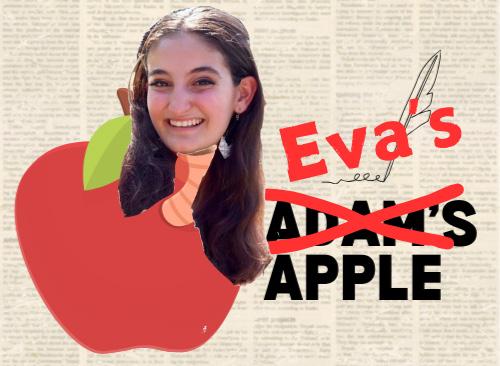
I am going to begin with a quick anecdote. This winter break, after a series of unfortunate events that included a 100meter dash through the Istanbul airport, I unexpectedly found myself in Dubai. Some weary travelers would have been upset that their flight pattern was disrupted. Many would have certainly preferred sleeping in a warm bed over watching “Despicable Me 4” in the sky. Not me. You see, dear reader, as I took off toward an unintended destination, I celebrated. I got ready to stay up an extra seven hours and texted my mom that I was about to visit the birthplace of “Love is Blind: Habibi.” I can only imagine that, at that moment, she had never felt more pride.
For those of you who have lived a sad existence and aren’t familiar with “Love is Blind: Habibi,” it is the version of the Netflix reality TV dating show “Love is Blind,” wherein people get engaged without ever seeing each other, that takes place in the Arab world. It is the single greatest thing ever created by humankind. Sliced bread pales in comparison. In fact, I firmly believe that I have achieved a level of moral, intellectual and argumentative dominance over my readership simply by having spent three hours in an airport that is only a one hour and 18 minute walk away from where they filmed the weddings for “Love is Blind: Habibi”.
So, where does that leave us? Well, this seemingly-tangential story serves many rhetorical purposes. First, it gives my article this week a bit of anecdotal charm. Second, it lets me mention my mom in the piece, and neither of my siblings have ever mentioned her in a publication, which thus makes me the favorite (???). And, lastly, this
is my ethos. I have just established a level of credibility that is beyond comprehension. This gripping story is my ticket to legitimacy. Legitimacy for what, you ask? For the question this week, which is as follows:
“How to fully get over last semester’s situationship?”
Now, if there is one thing I share with my predecessor, Adam, it is a respect for grammatical conventions. I bet you as a reader would love to see me just tear this person apart for how little this phrase even grammatically resembles a question. Tough luck.
I am an empath. I read this broken sentence structure, and I see a broken heart. Never fear, though; I am here to fix it.
You may have difficulty trusting me with such sensitive subject matter, because you don’t have any insight into what my life is like. Is Eva taken? Is she single? Is she ready to mingle? For all you know, I could very well be writing with the naive positionality of having spent the past seven years in my dream relationship (dating a real life character from Twilight, preferably named Jacob, maybe also a werewolf; the specificity is actually quite random and is for the sake of the argument). I could just as easily have written this question myself and been using this column as a coping mechanism.
Whether or not I have had personal experience with situationships, though, is actually irrelevant. What truly matters is my wealth of knowledge about the “Love is Blind” universe, which is basically an environment that forces the development of ten simultaneous situationships at any given time. So, without further ado, I present to you multiple very strong solutions to help get over last semester’s situationship.
1) Remember your worth. Behind this satirical facade of mine, there lies an individual who genuinely cares about your wellbeing. You mean more than what you meant to them. If they cannot see your value, they are not and never were the one for you. Sidebar: this is high-key poetic. Get me on one of those Flat Hat instagram quote slides stat.
2) Revenge. Last semester is still pretty recent. I bet you’re going through it, and that’s unfair. You may be familiar with the five stages of grief: denial, anger, bargaining, depression and acceptance. We are not dealing with grief here; we are dealing with vengeance. My proposed five stages of vengeance are a bit more specific and a bit more verb-y than noun-y. Step one: herd seven Canada geese into your quasi-ex’s dorm room. Step two: label these geese one through eight and skip number six. Step three: tip off their roommates that goose number six is very much real and is the craziest of them all. Step four: wait for chaos to ensue as your quasiex (and their poor roommates, who got unintentionally involved by associating themselves with someone lame) frantically search for imaginary goose number six. Step five: wear a custom shirt around campus labeled “Goose Number Six” and, when confronted, snidely remark to your quasi-ex “I bet it drove you crazy that you couldn’t catch this one.” It is baller and foolproof. You’re welcome.
3) Watch “Love is Blind: Habibi”. It will help you understand that many people have dealt with frustrating situationships, and that they made it out alright. It will restore your faith in love as you watch the lucky few find joy and companionship. Most importantly, it will bring you one step closer to being exactly like me. Enough said. I’ll leave you with one more suggestion. As an unbiased, objective opinions writer, I only have your best interest in mind. Although humility is my greatest quality, and it pains me to be so forward, I know this is the best advice I could give you. I would be remiss if I didn’t do everything possible to help you find happiness. With this, I give you option four.
4) Date me.
Okie dokie. See you in two weeks — or earlier. Dinner and a movie (“Twilight”) would be just fine.
EvaJaber‘28(she/her)isaprospectiveEnglishorinternationalrelationsmajor.Sheisamemberofthe Cleftomaniacs,anacappellagroup,an ESLtutorandhopestoencouragepeacemindedadvocacyoncampus.Contacther atehjaber@wm.edu.
NIH Cuts: How much is the health of a nation worth?
Kurt Williamson
FLAT HAT
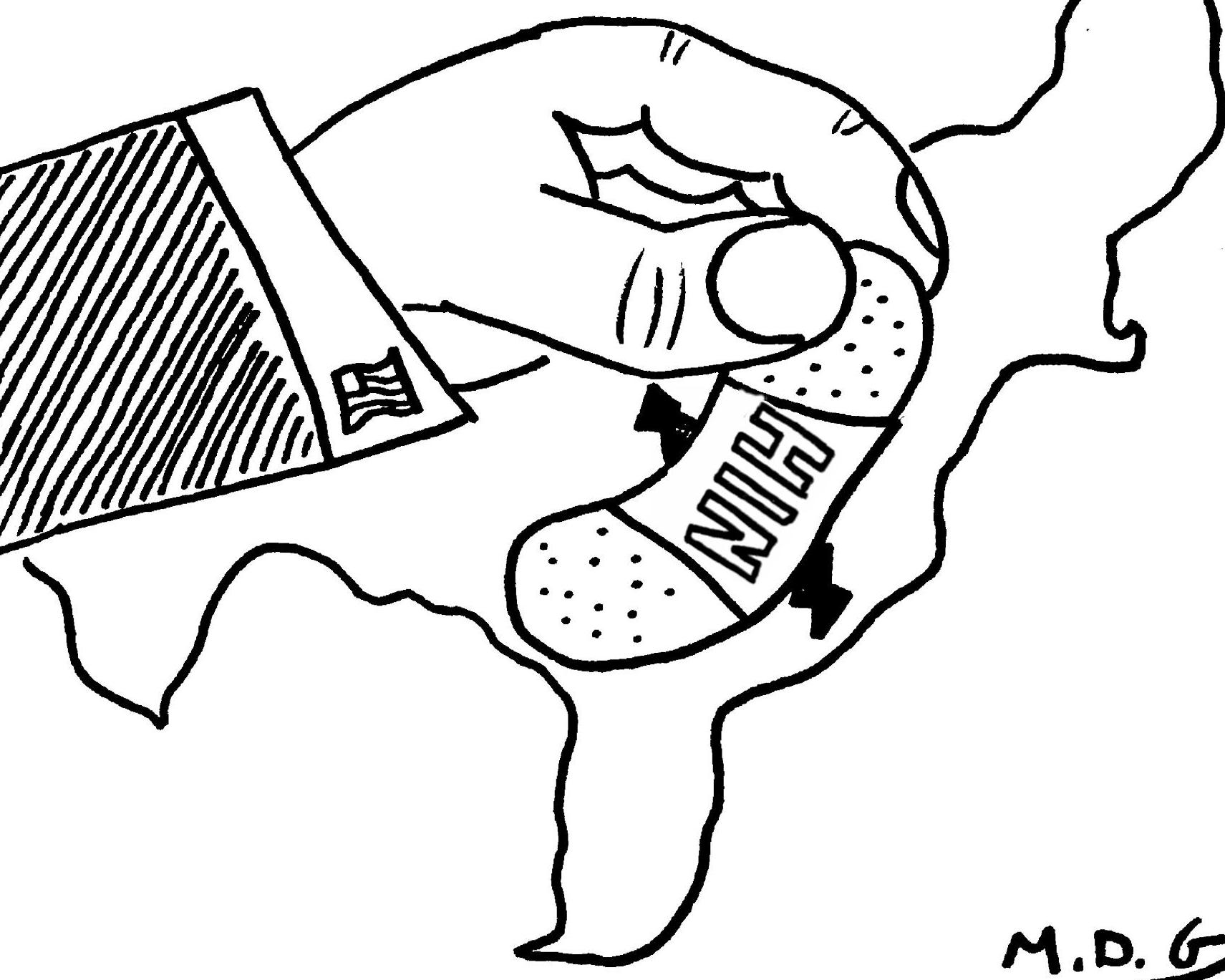
In the last month, many hasty decisions have been made in the name of supposedly increasing efficiency. While these decisions are having systemic effects across a growing number of federal agencies, I want to draw your attention to the impact on just one federal agency: the National Institutes of Health. Since it’s a big, bloated federal bureaucracy, it must be teeming with waste, middle managers and redundancy, right? And just look at these overhead rates. The NIH has had its day in the sun as a so-called ATM for scientists and it is time to freeze all funding and tighten the belt with across-the-board cuts NOW.
No doubt, inefficiencies could be identified and remedied with careful analysis and rational implementa-
tion. But the approach being employed is neither thoughtful nor careful, and it is downright dangerous. Before mindlessly hacking away at the NIH in the name of cost saving, we are obliged, first, to understand what the NIH is, what it does and what we get from our financial investment in its mission.
NIH stands for National Institutes of Health, whose stated mission is “to seek fundamental knowledge about the nature and behavior of living systems and the application of that knowledge to enhance health, lengthen life, and reduce illness and disability.” The agency started as the Marine Hospital Service in the late 1800s, later being formed into the National Institute (singular) of Health in 1930. Today, it is known as the National

Earlier this month, the College of William and Mary’s board of visitors declared 2025 as the “Year of the Environment” at the College. If you, like many of us, are looking at the state of the world and wondering what exactly this means, flounder no longer. I’ve compiled a short, handy list of tips for how to celebrate your own personal “Year of the Environment” here on campus.
1. Conserve
Are you eager to do your part in reducing carbon emissions, but have a few bad habits? Maybe you leave your light on, refusing to do homework in the dark, or maybe you use ChatGPT, despite knowing that its monthly carbon footprint (roughly 260 transatlantic flights) is almost equal to Taylor Swift’s. If this sounds like you, don’t worry; we’ve all been there! If you want to minimize your carbon effects, try recycling, shadowbanning Elon Musk on Twitter (since billionaires produce more carbon pollution in 90 minutes than you will in your entire life), keeping your showers to under 10 minutes and seed-bombing.
2. Spend time outdoors Get in touch with nature! You may have a hard time finding physical trees now that they’ve all been cut down for construction, but don’t worry, the new dorm buildings — Poplar, Maple, Oak and Pine — are all named after tree species indigenous to the region. The effect is incredibly authentic: If you close your eyes, you can almost imagine the sound of chirping birds.
While you’re on spring break next month, consider going for a hike! Take advantage of the week off to visit a national park — they’ll be less crowded than usual this time of year without all those park rangers! (Safety note: If you’re planning to visit southern California, make sure to minimize smoke inhalation by wearing an N-95 mask.)
3. Stay informed Our knowledge of science is constantly evolving! By the time this arti-
Institutes, plural, because the umbrella of NIH covers 27 different institutes and centers that focus on different aspects of human health and disease, including cancer, heart conditions, genetic disorders, aging, stroke and mental health. Which area(s) of human health should we stop investigating in an effort to save money and improve government efficiency?
Speaking of efficiency, let’s look at what we have received from our investment in the NIH: innovations in the form of drugs for treating cancer, pain, neurodegenerative diseases like Alzheimer’s and ALS and viral infections; interventions for managing pain, addiction and physical disabilities and advanced surgical procedures. These advances allow us to live longer, healthier lives than we otherwise would have without such investment. Which of these important benefits would you rather not have in order to save a little money?
Another critical benefit we receive from our investment in the NIH is innovation and job creation in the biotechnology sector. “Biotechnology” just means the interface between living systems and new developments in other fields like chemistry, electronics, computer science and physics. Some key examples of biotechnology that are fundamental to our quality of life today include the process by which we can safely make synthetic human insulin for treating diabetes (a biotechnology known as “expression vectors”), and DNA sequencing, which can reveal the genetic basis of a cancer cell or identify a new infectious disease agent. Without the research, testing and clinical trials sponsored by the NIH, we would not have the pace of innovation the United States enjoys, nor the economic benefits that
cle is published, leading science experts like Robert F. Kennedy Jr. may have discovered that the moon is in fact a wheel of cheese (though between you and I, I’m skeptical the moon exists at all). It’s important to stay informed, so make sure to routinely refresh your Twitter and Facebook feeds so you can be up-to-date with the latest scientific breakthroughs.
4. Buy second-hand Trying to save the environment and some money? Take advantage of Goodwill, Craigslist and the pop-up thrift events on Crim Dell Meadow to buy your clothes, furniture, eggs, gasoline, groceries and everything else that was supposed to be cheaper in this economy.
5. DON’T Collaborate
It’s important to remember — despite common misconceptions — that we are NOT in this fight together. Although all humans are experiencing the effects of rising temperatures as climate change exacerbates natural disasters, disease, habitat loss, poverty, water shortages, mental health and malnutrition around the world, slowing global warming is something one person or one country SHOULD do alone! That’s why the U.S. government has pulled out of the Paris Climate Accords — because an international agreement to reduce greenhouse gas emissions is a tacky waste of precious resources. As a country, we thought we’d be better on our own, and you should too.
Keep in mind: The climate crisis is your own individual fault. If you are experiencing quiet shame and hopelessness, these are appropriate feelings. DO NOT look to create meaningful impact through collaborative efforts or volunteering. Furthermore, please refrain from joining this campus’s many environmental groups, such as the Citizens’ Climate Lobby, the Minorities against the Climate Crisis Club, Compost Club or the Environment and Sustainability department. Though they may offer a sense of community, purpose and direction, they truly have your worst interests in mind and may in fact educate you on environmental issues. I find it best that you stay away.
LeliaCottin-RackisaprospectiveEnglishandreligioustudies doublemajor.Herinterestsinclude art,walkinginthewoods,cooking, reading,opposingfascismandcoffee. You can send her book recommendationsatljcottinrack@wm.edu.
arise from the development, marketing and application of these innovations. It is conservatively estimated that every $1 invested in NIH endeavors returns over $2.50 to the US economy on that investment. How much future growth are we willing to sacrifice for today’s cost-cutting?
One more important benefit that we receive from our investment in NIH is the training it provides to future researchers and physicians who will practice in the United States, to the benefit of U.S. citizens. The NIH administers dozens of programs (and invests millions of taxpayer dollars) to train and support scientists at all levels of their careers so that they can deliver the highest quality, highest impact results that lead to those previously mentioned improvements in our health and the length of our lifespans. Without a pipeline to train and support our best and brightest, where will our next-generation cancer treatments come from? Who will devise novel approaches to organ transplantation? How will we develop even safer and more effective interventions for opioid addiction? And how much are these new developments and improvements worth to you?
From where I sit, working with undergraduate students at the very beginning of their professional careers, the training and support of new and early-career scientists is a particularly hard blow that will affect all of us for years to come. Students who had been accepted for early-career experience through NIH summer research internships are receiving notices that these programs have been terminated. Students who had been accepted to competitive 2-year training fellowships at NIH, to prime them for biomedical research immediately after
completing their baccalaureate degrees, are likewise receiving cancellation notices. The internships, postbaccalaureate training programs and other foundational experiences offered by the NIH that would have set these students on paths to practicing medicine and conducting innovative medical research have all evaporated overnight. The Trump administration has decided that these students are not worth the investment, and the impact will be devastating.
The immediate impact will be a braindrain because our best and brightest will not find training or employment opportunities in the domestic biomedical sector and will either seek opportunities abroad or abandon medicine altogether, depriving our country of this important pipeline. As a result, our pace of innovation and development will decrease, and economic opportunities and biomedical advances will happen elsewhere — but not here. The ultimate consequence of today’s shortsightedness will be a decline in the overall quality of health and lifespan in the United States.
So, I end where I began: it’s not that large federal agencies like NIH cannot or should not be audited for sound financial practices, evaluated for program effectiveness and improved. I am sure they can, but that is not what’s happening now. The current administration is hurting you, and future generations of Americans, with this thoughtless and destructive approach, and it needs to stop.
KurtWilliamson,Ph.D.,isanassociate professorofbiology.Hisresearchfocuses onvirusesintheenvironmentandhe teachescoursesinvirologyandmolecular biology.Theviewsexpressedarehisown. Emailhimatkewilliamson@wm.edu.
ABBY FURCY AND ELLA GREENE // THE FLAT HAT
What makes a coffee shop popular? Is it location — an easy stop alongside the well trekked path from Swem to the Sadler Center (and then back to Swem, until 2 a.m., probably)? Is it price — an option that won’t crack open our already strained pockets? Is it the quality of the coffee itself? Or could it even be the music, creating a particular ambiance (You can never go wrong with Sabrina.)? This past week, we slid on our detective coats and put Town Center Cold Pressed under the magnifying glass, talking to student customers to reveal what truly makes Lodge 1 a permanent focal point of the “hustle and bustle” culture on the College of William and Mary’s campus.
Located on the first floor of Sadler, this cafe offers coffee, pastries, bagels, smoothies, acai bowls and more. We began by asking students what they ordered and why. After an hour, it became clear that there was a loose consensus on the most sought after food item. Any guesses?
If you said those delicious circular sandwiches with a hole in the middle, you’d be correct! Daniel Kalish ’25, for example, purchased a lox bagel.
“I’ve gotten a lox bagel before, and I had a positive experience with lox bagels in general, so I hope this specific instance of a lox bagel will reach that,” he said.
Sam Bergeron ’28 explained the reasoning behind his go-to order.
“It’s the bagel. That’s my favorite breakfast food, and this is the only place on campus that has it,” Bergeron said.
Leah Feldman ’27, who ordered the sausage, egg and cheese sandwich along with a latte, just wants something reliable.
“I get them every week, and they just don’t do me dirty,” Feldman said.
Bagels were by far the most purchased food item, with most students viewing it as a dependable decision. But the secondplace award goes to Cold Pressed’s selection of açai and smoothie bowls. Deanna Cena ’26, who ordered a dragonfruit smoothie bowl, is a veteran in this department.
“This is my go-to. I probably have this three times a week,” Cena said. “I usually don’t eat breakfast in the morning, so I get this after my first class of the day.”
Sometimes, all you need is a quick pick-me-up instead of a whole meal, and Cold Pressed more than has its bases covered. In regards to coffee, a simple iced coffee was the way to go for many sleep-deprived customers. Or, for those brave souls who needed a bit more oomph with no flavor or sweetener, a double espresso shot was also available.
“I went to the dining hall, and I already had two coffees there, so I didn’t want a full coffee,” Matthew Rosenthal ’25 said. “I just wanted a little bit more caffeine because I feel like the coffee in the dining hall is decaf, lowkey.”
As much as students love to plan their orders, there are also customers that enter Cold Pressed with a degree of spontaneity. In regards to quality of food and drink, no one is standing outside Sadler with a boombox over their head professing their undying love for the Morning Glory Smuice. However, all students remained satisfied despite some risk-taking, including Samantha Gaylor ’27, who purchased a green smoothie.
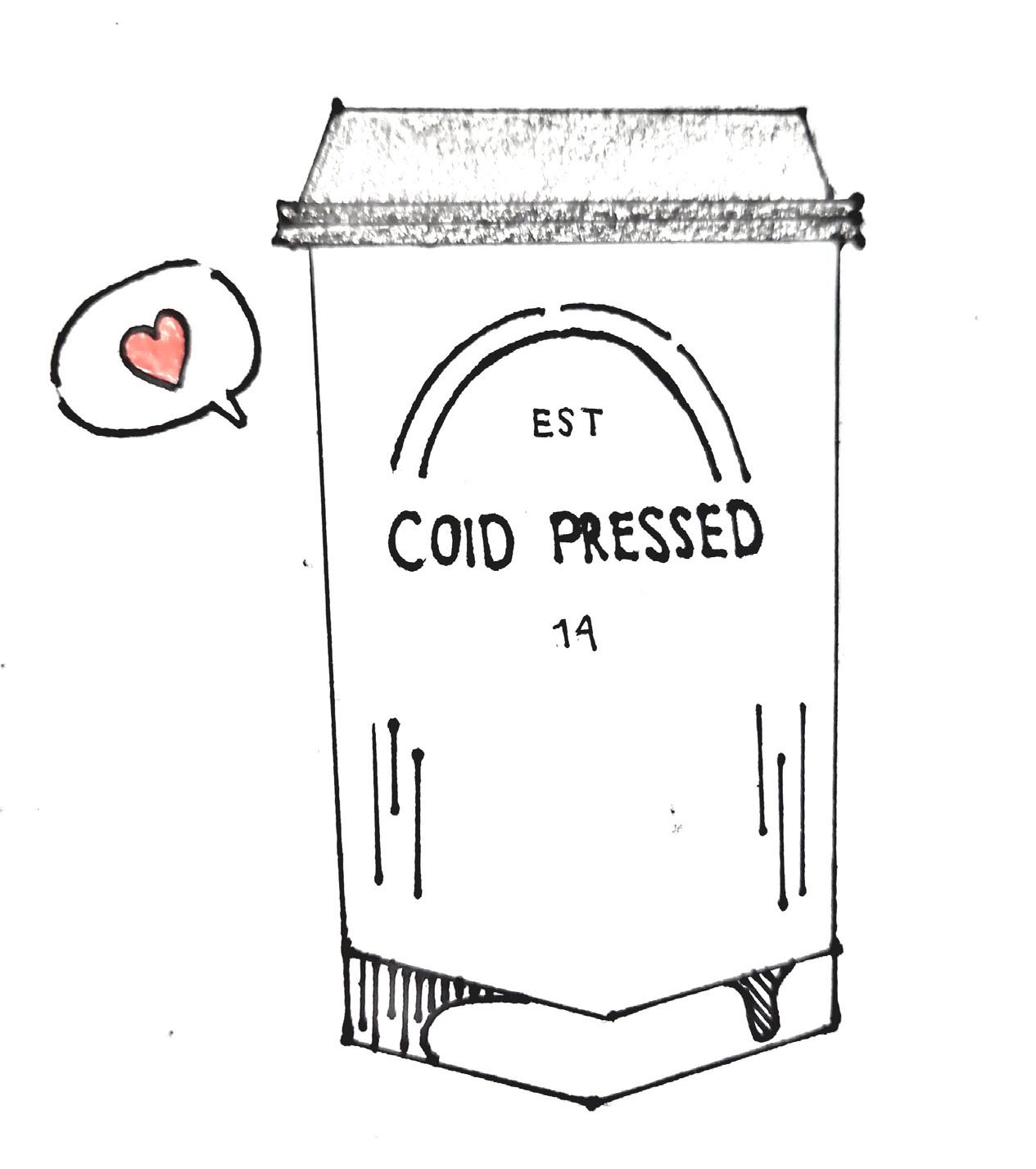
customers agree that the meal plan pillow is soft enough to cushion the sting of the high prices.
“It’s definitely on the more expensive side, but I don’t pay attention to that as much when I’m using my dining dollars,” McMahon said.
By mixing laughs with much-needed representation, the College of William and Mary’s Pink Tax Comedy club lends a distinct take on improvisational and sketch-based humor. The group offers a space for underrepresented gender minorities including women, non-binary people and transgender people in an effort to enhance diversity in the on-campus comedy scene.
The group is less than three years old, formed in the fall of 2022 to fill a gap in representation amongst the College’s numerous comedy troupes. In doing so, they have created a safe space to exercise their funny bones alongside people with shared identities and perspectives.
“I think it’s so awesome to be doing comedy with other women and nonbinary people because sometimes it can be tough to be a woman in comedy,” Vice President Ellie O’Neill ’26 said. “You sometimes feel like you’re forced to play female roles. For example, if you’re doing improv with a guy, you’re going to be whatever female character is in his story and his scene. In Pink Tax, though, you get to play all the roles, and it doesn’t matter who you are.”
In addition to offering a safe space, club member Katie Railsback ’26 finds that Pink Tax’s diverse membership affords the chance to take stereotypical depictions of women and turn them upside down.
“I think part of the fun in performing with other people who are part of these underrepresented genders is that we can make jokes that other people aren’t really in a position to be making,” Railsback said. “Us performers get to take a spin on it. We poke fun at women in comedy as women in comedy and get to reclaim that, as opposed to hearing a man say something like, ‘women aren’t funny.’ I think our audience appreciates that and relates to it as well.”
Pink Tax holds about three performances a semester where they can showcase their skills in front of a live audience.
“It doesn’t feel like an improv show, but more of a variety show,” O’Neill said. “We have songs and all sorts of out-there stuff that people are interested in doing, and we’re down to do it. We’re not putting ourselves in any type of box.”
A large part of these performances is audience interaction. Maggie Walters ’27 is new to Pink Tax this year and loves the feeling of changing how she delivers certain jokes and lines while on stage in
“I was worried it would taste like spinach, but it doesn’t. It tastes like mango,” she said. “I mean, there’s spinach in it, and you can’t taste it, so I would recommend it.”
Aside from laboring over the Grubhub app to craft the perfect Cold Pressed order, we wanted to get to the root of the appeal — what really motivates students to spend copious amounts of dining dollars in Lodge 1? After tugging at the stems a bit, we unearthed that its location in the center of campus means simple proximity is one of the largest draws.
“It feels a little overpriced, but it’s the convenience, you know. You’re already in Sadler, you don’t want to go up to the dining hall, so that’s what you’re paying for,” Kalish said.
Sadie McMahon ’27 agrees that the prices are a bit steep. Most
order to respond to the way a crowd reacts.
“It’s interesting seeing where people laugh at our jokes and sketches,” Walters said. “I like to adapt while I’m doing a performance by thinking, ‘I noticed they laughed really hard at that bit. I have a similar bit coming up that I’m going to really emphasize to make sure it gets a louder laugh than it might have in rehearsals.’”
Though these performances always contain an improvisational aspect, much more preparation goes into them than most audience members would likely assume. Pink Tax rehearses for about two hours every Sunday and Tuesday to hone their improv skills and make sure they can squeeze as many laughs as possible out of their prewritten sketches.
“A lot of people think you don’t really have to prepare for improv, but we’ll practice and judge what went well and what kind of didn’t, and then rerun a game from there so it feels better,” Walters said. “Obviously, you can’t plan what you’re saying or who you are, but there’s a lot of logistics in terms of how long the improv should go and what order of jokes would be funniest.”
Railsback finds it important that Pink Tax rehearsals can be a welcoming environment where people are willing to try new things in order to constantly improve their craft, even if a joke falls flat.
“When practicing an improv scene, sometimes you and your partner are super uncomfortable, super awkward and it’s not funny at all, but you can do that in a safe space,” Railsback said. “Other people aren’t judging you or going, ‘wow, you suck.’ Instead, you’re able to fail, and from there, people can offer advice and expertise. I think we all try to support each other and lift each other up.”
Besides improv, Pink Tax shows also include a series of sketches written by members. For O’Neill, these sketches are often based on personal experiences that she then molds into something more comical.
“For me, writing sketches usually has to do with little things in life that I think are silly or that I can do a play on words with,” O’Neill said. “You just write a sketch based on humor you find in something, and then you bring it to rehearsal. We then have a day where we edit each other’s sketches, looking out for plot and jokes and how we can tighten them up.”
This process of constant collaboration and rehearsal has turned Pink Tax into a tight-knit group, bonded not only by a love for comedy but
More than the quality of the food and drink comes into play for students choosing where to grab their coffee. For Brooke Drozdowski ’27, the music is one of the best parts of Cold Pressed.
“I love the music. I feel like they always have fire music tastes on,” she said. “Like yesterday, I think they have some Hozier playing. And then right now, I don’t know exactly what this is, but I feel like it really adds to the atmosphere.”
After spending two hours talking to student customers, it’s clear that Cold Pressed isn’t going anywhere anytime soon. Its convenient location, selection of bagels and the ability to use dining dollars make it a staple on the College’s campus. All in all, Cold Pressed may not deserve a Michelin Star, but it still receives the stamp of approval from most students.
by a sense of community as well. The club makes a concerted effort to continue maintaining this sense of community through hangouts, referred to as “Pink Tax dates.”
“We draw a name out of a hat and then you have to go meet up with that person during the week,” Railsback said. “I think it’s a really great way to integrate new people with people who have maybe been in the group for a while. I think all of our newer members are starting to see the effort we’re putting into looping them in.”
For O’Neill, Pink Tax is just as much a friend group as it is a comedy performance troupe, thanks in large part to a shared sense of wackiness.
“It’s people who aren’t afraid to put themselves out there and be a little silly, goofy and make fun of themselves,” O’Neill said. “We’re just a group of friends who sometimes do improv games. People aren’t silly enough in real life, so Pink Tax makes up for that.”
Being such a like-minded group of people has also allowed Pink Tax to form a series of unique traditions throughout its short lifespan, such as bonding over a shared love for reality competition TV shows.
“A lot of us are obsessed with the show ‘Survivor,’ so we do a lot of ‘Survivor’-themed stuff,” Walters said. “We did a ‘Survivor’ show last semester, and we do a lot of ‘Survivor’ improv games. We’re a very
‘Survivor’-geared group.”
The group’s latest performance was a puppet show held Friday, Feb. 28 — yet another chance to highlight their wacky approach to comedy.
“We all made sock puppets that look like each other,” Walters said. “A lot of the show is fully based on where the puppet is or what the puppet is doing. It’s been fun to see how the group adapted to our puppets in the frame of the stage or in adding a second character to the improv.”
In addition to increasingly unconventional show themes, Railsback views the club as constantly evolving, not only in the types of comedy it performs but in the importance of the representation it offers.
“Pink Tax started because comedy here was really male-dominated,” Railsback said. “I’m happy to say that in the present day, all the other comedy groups on campus have a really good distribution with very funny women and nonbinary people. But I’m really happy that Pink Tax was able to lead the charge in that way, and now we can just focus on comedy and supporting each other.”
Pink Tax has two more performances planned for this school year April 4 and 25. They also hold auditions every semester and are constantly looking for new members that bring fresh comedic perspectives to the group. For more information on shows and auditions, visit them on TribeLink or follow them on Instagram (@pinktaxcomedy).
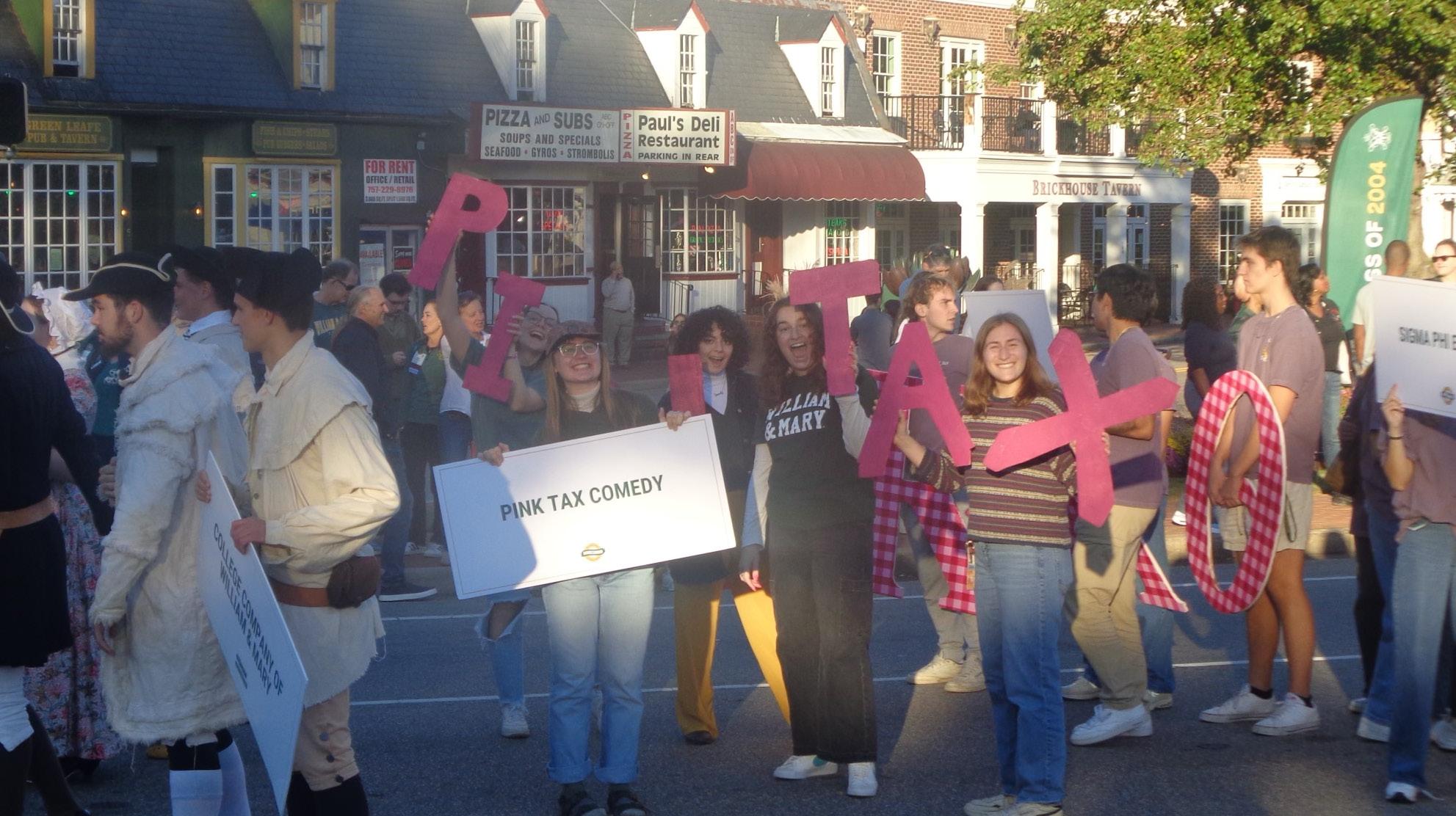
Through entertaining events and cultural conversations, the College of William and Mary’s African Cultural Society is dedicated to creating a space for African and African diasporic students on a predominantly white campus.
Along with their bi-weekly general body meetings, ACS hosts an array of events over the school year to celebrate African and African diasporic culture. Their fall benefit dinner raises money for a chosen charity with this year’s supporting The Person Center, an organization that works with refugee survivors of domestic violence. Multiple members noted the culture show, “I Rep Africa,” including poetry, dance performances and a fashion show, as their favorite experience of the club. ACS also runs long-term social programs like bigs and littles and a game of assassins.
The organization also has its fair share of interest-based offshoots.
The Diaspora DJs radio show on WCWM plays African and African diasporic music, the ABCs of Africa team competes in intramural sports and Afrodite performs AfroCaribbean dance.
“Just because it’s African Cultural Society doesn’t mean that you can’t come with whatever hobby you have and share that with the rest of the org,” ASC President Bemnet Legesse ’26 said.
Legesse joined the club as a freshman and was quickly drawn in by its inclusive environment. She served as historian last school year and president this year.
“I immediately made so many friends within the club, and it never felt like an obligation, never felt like a meeting, it was just I was literally hanging out with my friends once a week,” Legesse said.
Though ACS is specifically
dedicated to African cultures, the club maintains a close relationship with the Black Student Organization. The two groups’ memberships have plenty of overlap — largely due to the small number of Black students at the College, Legesse pointed out — and are mainly differentiated by the separate events each is responsible
overlaps with other organizations for Black students, including historically Black fraternities and sororities, the Africana House in Landrum Hall and the Black Male Collective.
ACS club member Naomi Idemudia ’28 said the extent of this overlap has actually discouraged her from joining other identity groups,
with other members of his culture at a predominantly white institution.
“It’s nice because there’s always a community. Wherever I go, when I see someone from ACS, there’s always like a conversation that starts, or we catch up with each other, and we’re always looking forward to the next
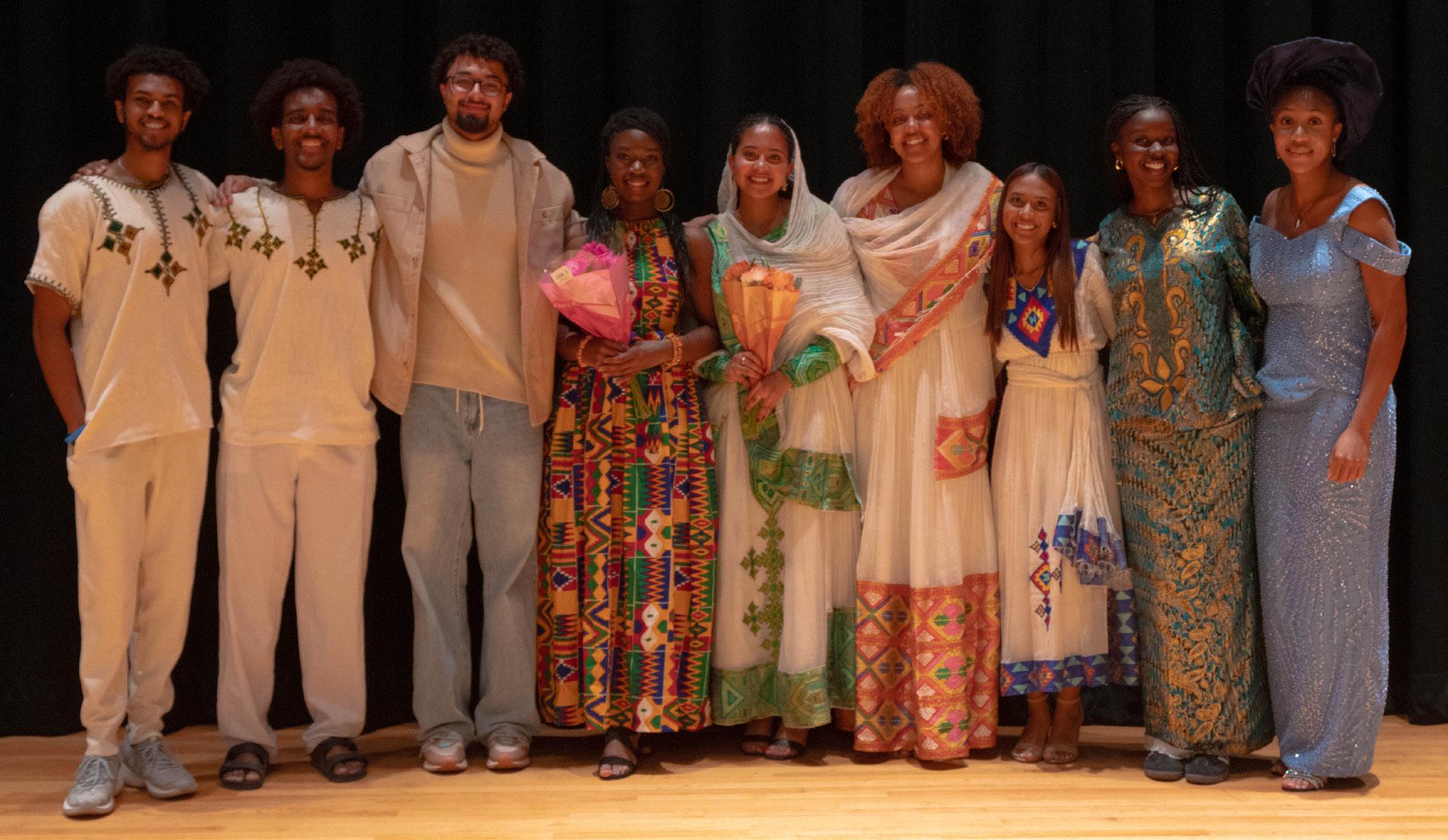
for organizing. “It seems like they’re two separate entities, but they’re really not; it’s one larger space. Our meetings are usually back-to-back, so people often just go to one, and then they walk right down the hall to the other.
Just trying to make it clear it’s one big community, and RSO or not, a community is a community,” Legesse said. ACS also collaborates and
noting other club members can feel stretched thin by participating in multiple similar organizations.
“I wish there was more differences between the groups to make them more interesting,” Idemudia said. “It’s also nice to have different forms of community, but most people who are in ACS I know are also in BSO.”
Club member Henok Sentayhu ’28 heard about ACS on his first day of classes and joined to connect
ACS meeting,” Sentayhu said. Legesse observed that, since her freshman year, ACS has seen decreased attendance. She added that, according to friends in other organizations, the trend of decreased turnout is common across campus.
“I think that there’s just less enthusiasm, and maybe people are just putting more time into maybe not MCOs, but more interest-based things,” Legesse said. “That could
be it, too. Maybe just a cultural org is not as satisfying as maybe chess club or something.”
To increase attendance, Legesse hopes to host more fun, casual events. For instance, members consistently described a recent general body meeting featuring a game of “pop the balloon” as a highlight of the semester with notably high turnout. Attendees popped their balloons based on whether they agreed with an opinion statement.
“Maybe fun, stupid events are what people want right now,” Legesse said. “Things are getting too serious across the board, so I think people just want, when I come to this meeting on Tuesday at 6:00 p.m., classes are done, I just want to do something stupid and fun. As long as it’s not crazy stupid, I think that’s harmless. I think harmless fun is the solution.”
ACS members praised the engaging activities at the club’s general body meetings beyond just delivering announcements. Idemudia, who was brought to the first ACS meeting of the semester by hallmate Sentayhu, explained that the meetings have helped her build a network on campus amidst anxiety as a freshman.
“As a more introverted type of person, I kind of need an activity to interact with people, and they do a great job facilitating that most of the time,” Idemudia said.
ACS will be hosting a Feb. 28 screening of “One of Them Days” in Commonwealth Auditorium in collaboration with the Center for Student Diversity. ACS also collaborated with the CSD in planning recipes for Taste of Soul, held Feb. 19 in Sadler Center Court.
CASSIDY JONES // THE FLAT HAT

Thursday, Feb. 27, Museum University Student Engagement presented its inaugural event, “Student Jazz Night,” at the newly renovated Muscarelle Museum Of Art. The performance featured student group Wham Bam Little Band and professional Richmondbased group Weldon Hill. With a small army of volunteers and a not-so-small army of an audience, the Muscarelle was filled for the first of what MUSE hopes will be a long series of concerts, exhibitions and events.
The event opened with a performance by Wham Bam Little Band, a student-led jazz group that performs at on and off campus events. The Little Band consisted of seven members: a pianist, guitarist, bassist and drummer, as well as three saxophones.
Little Band is a subsection of Wham Bam Big Band, which is exactly what it sounds like — the larger, complete jazz band. Big Band puts on various performances throughout the semester; however, Little Band is available for hire at whatever event needs some jazz to spice up the mood: a cocktail hour, fundraiser or even the College of William and Mary Yule
Log ceremony. Antonios Tsompanidis ’26, the current director of both bands, was one of the performers ursday night, playing the alto saxophone.
“We’re trying to promote jazz throughout campus for smaller events and whatnot,” Tsompanidis said. Tsompanidis expanded on the difference between the Little and Big Bands.
“This setting allows you to be more, in a way, intimate with the different people that you’ve met in the Big Band, but you explore the traditional standards as they’re called,” Tsompanidis said. “It’s just a larger sound, divisions and dissections, saxophones, trombones, trumpets, full sound, full rhythm.”
The Little Band website mentions that Little Band can be as large or small as needed, ranging from three pianists to an 8-piece combo with vocals to boot.
After the Little Band played its set for the first half of the event, Richmond-based guest group Weldon Hill took the stage. Weldon Hill is headed by its pianist for whom the group is named and consists of James Gates
on saxophone, Billy Williams on drums and Michael Hawkins on bass.
Hill is a jazz composer who has performed with the Virginia Symphony Jazz Orchestra and Symphony Pops, the United States Air Force Rhythm in Blues Jazz Ensemble and countless modern masters of jazz. Each artist playing with Hill at the event had their own repertoire and history, bringing an individual style to the band.
Weldon Hill captivated the audience for the better part of an hour, with performances including one song written by Hawkins, before eventually bringing Little Band back to the stage for an impromptu and collaborative finale. The bands played together with little communication beyond a glance and their shared understanding of the language and standards of the music they played, even giving time for every artist to have a brief solo performance. Tsompanidis commented on being invited to play alongside Weldon Hill.
“We had no idea that was going to happen,” Tsompanidis said. “It’s awesome to be able to do that.”
The Little Band’s excitement to play alongside Weldon Hill was palpable as the musicians smiled and laughed when not actively playing. The result was a quite lengthy round of applause from the audience.
MUSE, a recently formed organization that promotes the link between students and the newly reopened Muscarelle Museum, organized the entire night. Co-chairs Max Belmar ’25 and Sierra Manja ’26 provided insight as to what MUSE does.
“We’re really eager to bring new voices and students of all majors into the museum space,” Manja said. “We just want to open up that sort of exclusive environment that the museum has historical background into everyone.”
Museums often create opportunities for people who would not ordinarily come across arts in their daily lives or professions.
Belmar added that MUSE hopes to use such a strategy to boost the Muscarelle’s presence across campus.
“We’re trying to sort of bridge the gap between STEM and humanities,” Belmar said. “I feel that with events like these, and then some of our lecture series events coming
up later in the spring, we could sort of bridge that gap.” Williamsburg residents can follow MUSE on Instagram (@muse.wm) for updates on upcoming events and ways to get involved and check out the Muscarelle Museum website for upcoming events, exhibits and more.
Students interested in performances by Wham Bam’s Big and Little Bands can check out their website at whambambigband. weebly.com or follow them on Instagram (@ whambambigband).
For more information on Weldon Hill, visit his official website at weldonhill.com.
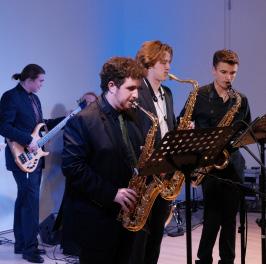
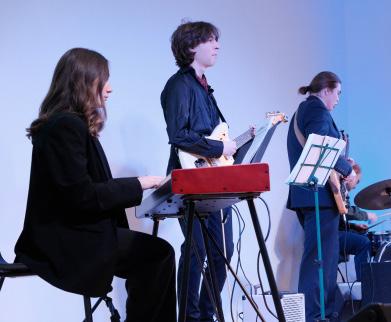
On the other side of the break, the Tribe put out its initial starters. However, Ndur was quickly substituted out after committing back-to-back fouls less than a minute into the half.
Northeastern began the scoring as Pratt got open on the interior for an easy two-pointer before Woods doubled up with a layup of his own.
The Tribe moved quickly. Junior guard Chase Lowe pushed the ball up to Case, who drove to the hoop for an and-one layup. Case nailed the free throw and extended the William and Mary lead to 43-35.
Case continued to be aggressive in the paint, drawing another shooting foul at the 17:00 mark. He missed the first free throw but made the second.
Junior guard Kyle Pulliam made his first field goal of the game at the 15:42 mark, driving inside for a contested layup to put the Tribe up 47-39.
William and Mary was able to push its lead to 11 thanks to six consecutive points from junior forward Finn Lally. All six points were scored in the post, as Lally backed down and finished over several Northeastern defenders.
Northeastern responded with an 8-0 scoring run powered by Woods and junior guard Rashad King, trimming the Tribe’s lead to 53-50.
Gabe Dorsey found a cutting Caleb Dorsey to stop the

Huskies’ streak, but the visitors tacked on two more field goals, pulling them within one point of William and Mary.
Both teams traded baskets until a pair of King free throws at the 8:18 mark gave Northeastern a 60-59 advantage –– its first lead of the game.
The back-and-forth scoring continued as the lead changed sides six times in the last eight minutes of regulation.
Mbeng reclaimed the advantage for the Tribe, going the entire length of the court for a contact layup. Fritz responded for Northeastern with two points of his own. Lowe was fouled on the following possession and made both free throws.
Following a Case turnover, King converted an easy breakaway layup, but Case made up for it with an aggressive drive that drew a shooting foul. He made both his free throws, putting the Tribe up 65-64 at the three minute, 19 second mark. Frankel retook the lead for the Huskies on the next possession by nailing a wing three-pointer.
Using the same strategy as before, Case drove into the paint and drew another shooting foul. This time, the guard failed to make either of his two free throws to potentially tie the game.
The Tribe had another opportunity to even the score when Lowe was sent to the line for two attempts. Lowe made the first but missed the second, and the Tribe remained down by one point with 1:56 left in the game.
Frankel extended the visitors’ lead to two after he made a free throw following a Caleb Dorsey foul.
Earl proceeded to call a timeout, but the Tribe offense still found itself out of sorts. Clearly frustrated, Earl called another timeout with five seconds left in the shot clock to draw up a play.
Following the second timeout, Boothby was passed the ball at the wing. Unable to find any of his open teammates as time expired, Boothby was forced to hoist a contested threepointer that didn’t find the rim.
On the subsequent Northeastern inbound, the Tribe’s press forced a haphazard cross-court pass to sophomore guard William Kermoury, who fell out of bounds and handed the Tribe a much needed turnover.
With 50 seconds left in the game and the score 68-66 in favor of the Huskies, the Tribe chose to play through Lowe, who drove inside. Lowe found himself tangled up underneath the basket, causing Earl to use his final timeout.
On the other side of the break, the Tribe once again went to Lowe, who drove into the paint. Lowe got his layup to fall and drew an and-one call, sending the Kaplan Arena crowd into a frenzy.
“We tried to get Chase [Lowe] to switch with a smaller guy,” Earl said. “It’s all about matchups. Bigger guy on a smaller guy to get it in there, and that’s what the thinking was.”
With the opportunity to give his team the lead with 34 seconds left, Lowe was unable to make his free throw, leaving the game tied at 68-68.
Woods grabbed the rebound for Northeastern and pushed the ball across half court, calling a timeout to draw a play up.
With 30 seconds left, the Huskies elected to play through King, who stood at midcourt and waited to drain the clock. Case stood between him and the basket as all of Kaplan waited in anticipation. With around six seconds left in the shot clock, King made his move and drove to the left elbow. He took one dribble and stepped back, rising over Case and nailing a go-ahead mid-range jumper.
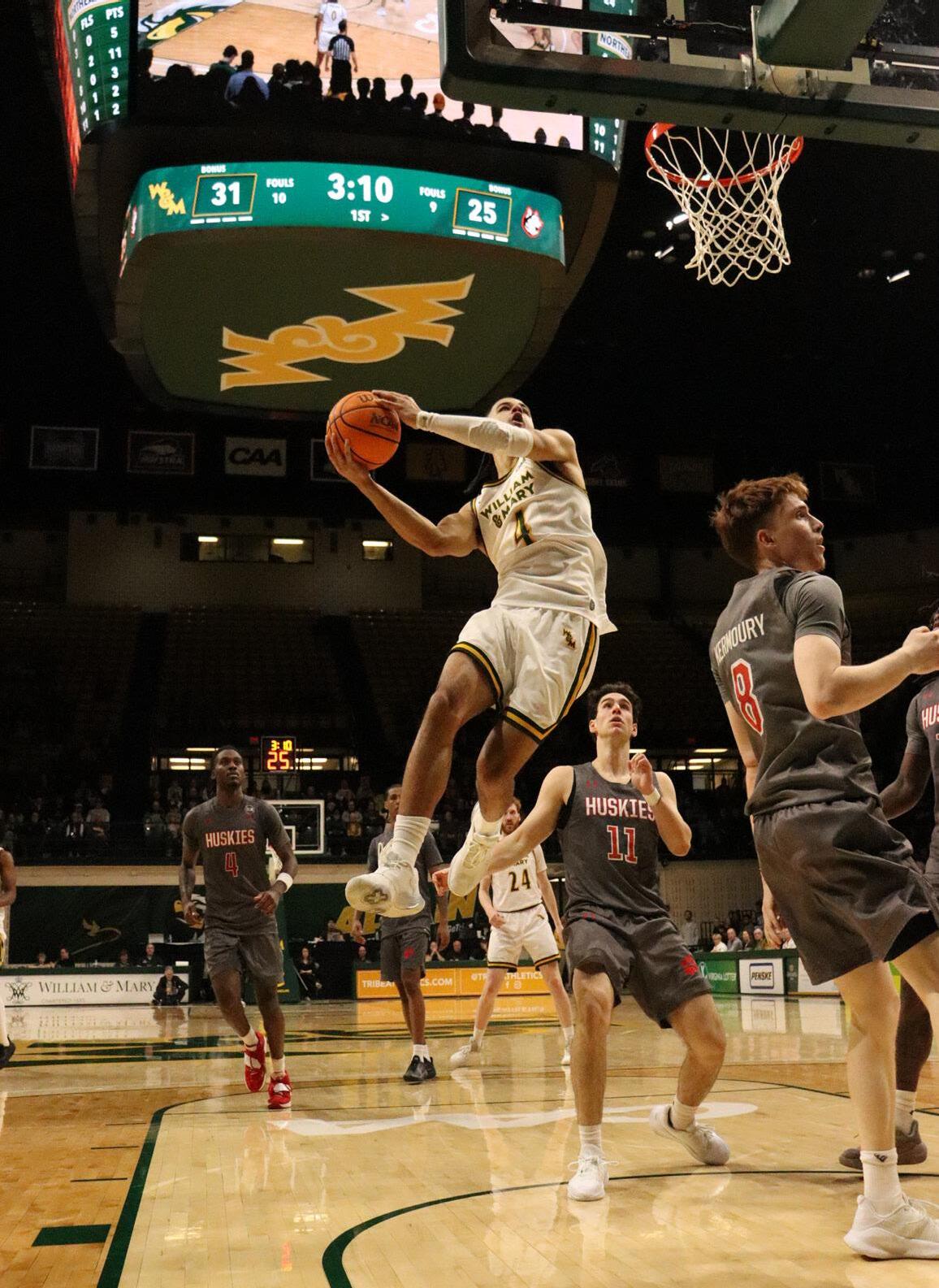
five
to Gabe Dorsey near midcourt. Dorsey chucked up a buzzerbeating deep three-point attempt that hit the left side of the rim, and Northeastern escaped with a 70-68 victory.
Caleb Dorsey led the Tribe in scoring with 20 points on the afternoon, shooting perfect from the field and free throw line. Case joined him in double digit scoring with 11, while Mbeng and Lowe followed with eight and seven points, respectively.
“Just a tough outing. I thought we had things going at our pace to start the game, and it just slowed down,” Earl said. “We need to figure out a way to get some easier baskets. Turnovers were obviously a major thing. We just need to make sure we’re taking care of the ball and execute down the stretch.”
Despite dropping this game, the Tribe clinched the fourth seed in the CAA standings due to losses suffered by Campbell (15-16, 10-8 CAA) and Monmouth (12-19, 10-8 CAA).
Top-four teams receive a double-bye into the quarterfinals of the CAA Championships. The winner of the 14-team tournament will claim the CAA title and receive the conference’s automatic bid into the NCAA tournament.
“We’ll go through this game and make sure we’re executing,” Earl said. “From a basketball perspective, we need to deal with how other teams are guarding us. It will be a physical week of practice.”
The No. 4 Tribe will receive a double-bye into the quarterfinals and face No. 5 Campbell, No. 12 Delaware (12-19, 5-13 CAA) or No. 13 Stony Brook (8-23, 4-14 CAA) Sunday, March 9 at the Entertainment and Sports Arena in Washington, D.C.
William and Mary women’s basketball (11-16, 8-8 CAA) played its final home games of the season over the weekend, defeating Northeastern (2-23, 1-15 CAA) 71-51 before falling 54-34 to Hofstra (12-15, 7-9 CAA).
The Tribe lost five of its last six contests and dropped into a three-way tie for sixth in the Coastal Athletic Association standings.
The Green and Gold can no longer finish in the league’s top four, meaning they are eliminated from receiving a double-bye in the conference tournament.
Friday, Feb. 28, the Tribe cruised past Northeastern at Kaplan Arena, never trailing during a dominant victory over the last place Huskies. Early on, William and Mary was carried by its backcourt duo of senior guard Bella Nascimento and sophomore guard Cassidy Geddes, who head coach Erin Dickerson Davis implored to be more consistent after a Feb. 21 loss to North Carolina A&T (17-10, 13-3 CAA) in which the pair combined to make just six of 26 field goal attempts.
Out of the gate, Nascimento and Geddes proved they took their coach’s words to heart, making eight of their first ten field goal attempts and staking the Green and Gold to a 25-13 lead at the end of the first quarter.
“I’m very proud of how our team attacked this game,” Dickerson Davis said. “The last time we played Northeastern, I think that
we didn’t come in with the aggression that we needed to be successful. We ended up pulling it out, but I mean literally at the very end, as opposed to today, where I think we were in attack mode from the very jump.”
Geddes echoed a similar sentiment, highlighting the team’s determination.
“We were really trying to focus on — even in warm-ups — coming out with the right energy, the right mindset,” Geddes said. “So that led us straight into the game, being able to start strong. We started out aggressive in our press and we know that really gets us going for the rest of the game.”
Behind the efforts of freshman center
Alyssa Staten, the Huskies prevented the Tribe from extending its lead during the second quarter and entered the half trailing 40-26. On the other side of the break, seven third-quarter points from freshman center Natalie Fox gave the Green and Gold a spark and extended the hosts’ lead to 55-34.
Fox finished the night with a career-high 11 points along with five rebounds.
“I feel like we did a really good job of screening and rolling and catching me when I was open on the roll,” Fox said. “A lot of times, I feel like it was just a quick screen and roll, and it was an easy basket, which is something we actually have been working on a lot in practice. So it’s nice to see it translate to the game.”
The Tribe smothered its opponents during the third quarter, holding them to 20% field goal shooting and forcing seven
Husky turnovers. Although Northeastern found more offensive success in the subsequent quarter, a late six point burst from senior forward Anahi-Lee Cauley put the cherry on top of the Green and Gold’s lopsided victory.
Dickerson Davis lauded the performances of Fox and Geddes, the latter of whom scored 17 points on 50% three-point shooting.
“Both of them have really just locked into what we need them to do,” Dickerson Davis said. “Because of that — I knew it when we recruited them, and I know that the same today — they’re going to have an amazing career here. I just hope now they help put on for the seniors and my two juniors that are graduating on Sunday. They are a big piece of what we do, and those are the shoes that these two plus some of our other young players will be filling.”
Sunday, March 2, the Tribe hosted its Senior Day against Hofstra, honoring junior guard Alexa Mikeska, junior forward Kayla Rolph, graduate student center Kayla Beckwith, graduate student forward Rebekah Frisby-Smith, Nascimento and Cauley. Mikeska got the scoring started for the Green and Gold, and her four early points would keep the Tribe competitive during a defense-oriented first quarter. When the first ten minutes concluded, William and Mary was trailing 8-7.
The Tribe would again score eight points during the second quarter, but its opponents did not follow suit. Hofstra blew
the game open with a 19 point frame that saw the visitors shoot 52.9% from the floor and outrebound the hosts 15-7.
The next two periods were similar stories: the Pride slowly increased its advantage while the Tribe failed to find any offensive rhythm. A brief offensive eruption from Cauley and Frisby-Smith during the early minutes of the third quarter closed the gap to 28-24, but William and Mary soon fell behind again for good.
That night, the Green and Gold scored 34 points and made only 14 of its 59 field goal attempts, good for 23.7%. Only four times since the turn of the century had the Tribe previously scored so few points in a single game; only six times since the turn of the century had the Tribe previously made such a low percentage of its field goals in a single game.
Nascimento scored four points while making just two of her 19 field goal attempts. Rolph, Geddes and Cauley were only marginally more efficient, combining to shoot 26.9% from the floor. As a team, the Green and Gold were outrebounded 4533 and saw no individual player break the double digit scoring threshold.
The Tribe will return to the court Thursday, March 6 to take on league-leading NC A&T at Corbett Sports Center in Greensboro, N.C. The Green and Gold will then travel to the John W. Pope Jr. Convocation Center in Buies Creek, N.C. to face off against Campbell Saturday, March 8.
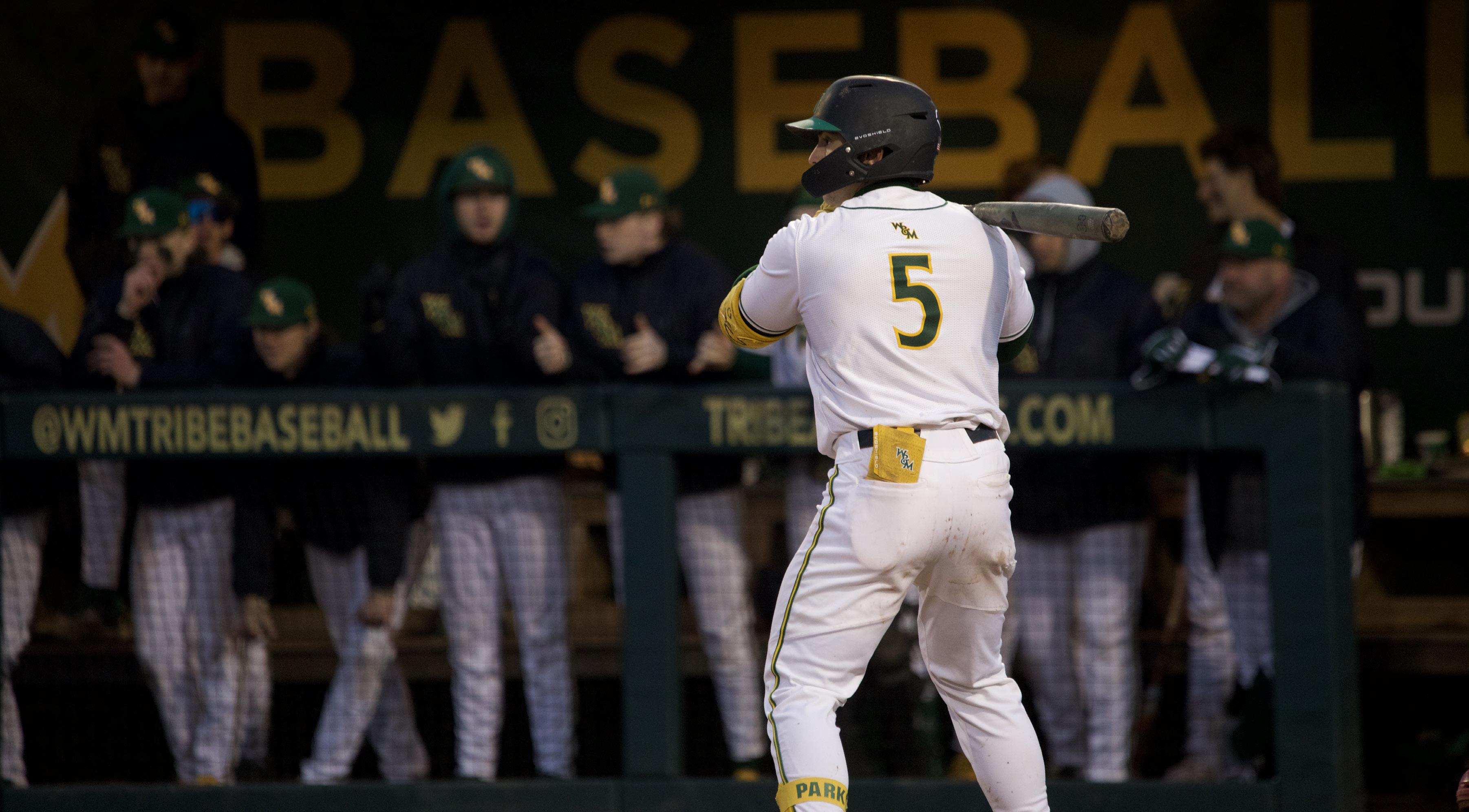
Friday, Feb. 28, Saturday, Mar. 1 and Sunday, Mar. 2,
William & Mary baseball (4-7, 0-0 CAA) hosted the Central Virginia Challenge tournament, losing games to Boston College (4-4, 0-0 ACC), Toledo (4-6, 0-0 MAC) and Penn State (8-1, 0-0 Big 10) at Plumeri Park in Williamsburg, Va.
On Friday, the Tribe fell 14-11 to Boston College in a game where the Green and Gold led by as many as six runs at one point. The afternoon started quietly, as neither team scored runs in the first inning. That trend soon changed, as a wild second inning saw ten total runners cross home plate. The visitors’ half of the second saw the Eagles score four runs, aided in part by two Tribe errors, but William and Mary instantly mounted a response with a six-run bottom of the second. Freshman infielder Jamie Laskofski notched a twoRBI single to put the Green and Gold on the board. After subsequent RBIs by graduate student outfielder Ben Parker and senior outfielder Lucas Carmichael, senior outfielder Christian Rush singled home two more runners and the inning ended with the Tribe leading 6-4.
Senior right-handed pitcher Carter Lovasz, who replaced freshman RHP Jack Weight during the second inning, controlled the game during his tenure on the mound. Against a typically productive Boston College offense, Lovasz conceded only two runs through his 4.2 innings of work.
The third inning saw Laskofski score one runner on a single. Rush again answered the call in the fourth inning, when he slammed a 3-run homer to make the score 10-5.
After Carmichael scored off a single in the fifth, it was all Eagles. The Tribe committed two more errors as the Eagles poured in nine unanswered runs over the last four innings,
eventually taking a 14-11 lead. The Tribe was given a chance to even the score in the bottom of the ninth, but graduate student infielder Ethan Rothstein struck out with two men on base and ended the game.
“For seven of the nine innings we played pretty well,” head coach Rob McCoy said. “All in all, I was happy with the effort, but we need to make plays.”
On Saturday, the Tribe fell to the Toledo Rockets by a score of 7-2. Three Toledo players launched solo home runs in each of the first three innings against senior RHP Reed Interdonato. The hosts were unable to score until the sixth, when Carmichael’s single drove Parker home following a triple by the latter. Unfortunately, the Tribe was only able to scratch one more run across the plate, and the Rockets went on to cruise to a victory.
The Tribe’s lackluster offensive performance amplified the frustration of the loss. The Green and Gold outhit Toledo 107, but they could only draw one walk. Additionally, the Tribe missed many scoring opportunities and left a total of eight runners on base.
“We can’t count on putting up 10 runs every time we play,” McCoy said. “At the end of the day if you can’t score runs, and give up too many, it’s not gonna work out well for you. We played better today than we did yesterday, but it’s still not good enough.”
The Tribe fell 7-6 to Penn State to conclude the weekend.
The Green and Gold began the day strong, holding the Nittany Lions to just one hit and no runs in the top of the first. Sophomore first baseman Anthony Greco opened the scoring for the hosts, singling to centerfield and plating Laskofski. Graduate student utility player Derek Holmes followed with a two-RBI single, and the Tribe left the inning leading 3-0.
The top of the second saw Penn State score three, aided by the Tribe’s 33rd and 34th errors of the season. While the third and fourth innings saw no runs, the Nittany Lions plated two men off of a double from senior center fielder Matt Maloney in the fifth. The home frame saw Holmes record another RBI, and the score sat at 5-4 as the Tribe left two men on base.
The Green and Gold was able to tie the game in the bottom of the sixth courtesy of a Carmichael single that scored Laskofski. Missed opportunities would again haunt the Tribe, with the team once more leaving two on base.
Maloney smacked another RBI in the seventh, but the Tribe benefited from a timely Penn State error in the bottom of the inning, as a single from junior outfielder Charlie Iriotakis evened the score at six. The frame ended with the hosts leaving three more men stranded.
After a quiet eighth, the Nittany Lions struck again in the ninth. A wild pitch by junior pitcher Owen Pierce created an opening that the visitors took advantage of, sending the goahead run across home plate as the Tribe attempted to recover the ball. Weight replaced Pierce, and the former pitched the final 0.2 innings without allowing a score. However, the Tribe could not score in the bottom, and the Nittany Lions escaped Williamsburg with a victory.
“I’m not discouraged at all,” McCoy said, stressing that his focus remains on getting the team focused on overcoming its mistakes. “We played a decent ball game, it’s just when you play a really good team, the margin for error is really small.”
McCoy remains optimistic about the rest of the season. “We’re about to get some guys back and healthy, which will be good.”
The Tribe went on to drop a midweek game to #9 Virginia (8-3, 0-0 ACC) by a score of 15-4. The Green and Gold will return to the field Wednesday, March 5 against VCU (2-9 , 0-0 A10) at The Diamond in Richmond, Va.
Despite coming off bench, Maryland native leads Tribe in assists, games played, steals
SYDNEY WITWER FLAT HAT SPORTS ASSOC.
Isaiah Mbeng has been a pleasant surprise in his debut season for William and Mary men’s basketball. The 6’1” freshman guard from Potomac, Maryland has had no problem making an impact early in his college athletic career.
Mbeng attended Winston Churchill High School, followed by a year of schooling at Prolific Prep. During his season of postgraduate basketball, Mbeng averaged just under 18 points per game, six assists, and five rebounds per game. He was named first-team all-county and was ranked No. 13 for players in the DMV area.
Coming from a dominant year before his start with the Tribe, Mbeng still had the lofty task of translating his talent to the Division 1 level.
“It was pretty smooth,” Mbeng said of his transition to playing at the college level. “I always played with college guys during the summers when I was in high school, so I kind of got a feel for it.”
Mbeng was introduced to the sport by his
older siblings.
“I grew up with five older brothers, and they were playing before I was even born, so I was always around [the game],” Mbeng said.
Mbeng’s older brother, Bez, is currently a senior playing at Yale, where he has been named Ivy League Defensive Player of the Year two years in a row. Bez currently has 143 career steals as a Bulldog and was third in school history for steals entering the 2024-25 season.
Mbeng made his Tribe debut in its first game against D-III opponent Dickinson at Kaplan Arena. He notched 11 points, three steals and only one turnover in his 16 minutes off the bench. The game was the beginning of a successful debut season for Mbeng. He has played in all of the Tribe’s games up to this point, averaging 19.7 minutes per game and recording totals of 177 points, 43 steals and 105 assists.
His game highs include 15 points versus Stony Brook, four steals versus Monmouth and seven assists against North Carolina Wilmington. Mbeng was also named the Coastal Athletic Association Rookie of the Week twice this season, the first time in the week of Jan. 6 following his
performances against Hofstra and Stony Brook and the second time the week of Jan. 27 after games against UNCW and Hampton.
Mbeng’s successful season has come during an exciting time for Tribe basketball. The Tribe is currently 17-14 (11-7 CAA) and is hoping to further their success as the CAA tournament approaches next week. The team will enjoy a tworound bye and begin the grueling slate of games with a free pass into the quarterfinals. Winning the tournament would grant the Green and Gold an automatic berth into the NCAA Tournament, a feat that has escaped the Tribe for the team’s entire history.
Mbeng expressed his excitement about the possibility of playing in March Madness, arguably the most prestigious competition in college athletics.
“I think it’s crazy! It’s something I’ve dreamed about for so long and now that it’s very possible, it feels great. And to do it with William and Mary, who have never been to it, makes it even better,” he said.
Mbeng’s enthusiasm is echoed by the entire team, as well as William and Mary’s fans. Game
attendances have soared, with Feb. 15 home matchup against Drexel attracting 5,103 people to Kaplan Arena, the largest announced home attendance since February 2020.
With all the excitement surrounding the team, having a strong support system is of the utmost importance. Aside from his family members, Mbeng has leaned on teammates, including freshman guard Luke Kinkade.
“He gives me some pretty good advice and I think with both of us being freshmen, we’ve been able to figure a lot of stuff out together,” Mbeng said of the guard from Naperville, Illinois.
Mbeng also commented on the strength of the Tribe’s coaching staff.
“The coaching staff has been great. Since the summer they’ve helped me learn a lot and have instilled confidence in me throughout the year,” he said.
Mbeng’s Tribe career has started off with a bang. The freshman has been a bright spot in a successful season for the Green and Gold, providing an offensive spark with his playmaking off the bench. With the postseason looming, there is still plenty of time for Mbeng to make more impact.